Paul van Yperen's Blog, page 299
August 16, 2017
Naufragio (1916)
Italian child star Ermanno Roveri (1903-1968) played the lead in the silent melodrama Naufragio (Umberto Paradisi, 1916). Naufragio was part of a series of films based on the stories in Cuore (1886) by Edmondo De Amicis.
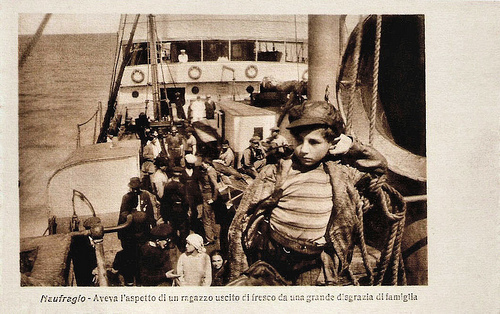
Italian postcard by Film Artistica Gloria, Torino (Turin), no. 3404. Printed by Uff. Rev. St. Terni, 16-5-17. Caption: He had the look of a boy who just came out of a big family misfortune.
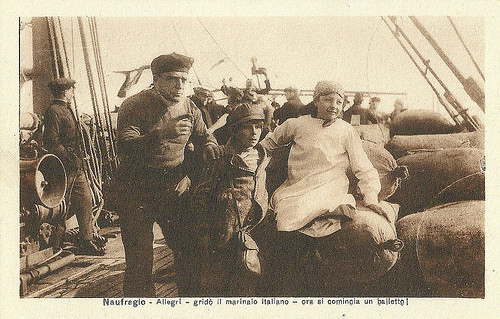
Italian postcard by Film Artistica Floria, Torino (Turin), no. 3404. Printed by Uff. Rev. St. Terni, 16-5-17. Caption: Be cheerful, the Italian sailor cried to them, now a ballet starts!
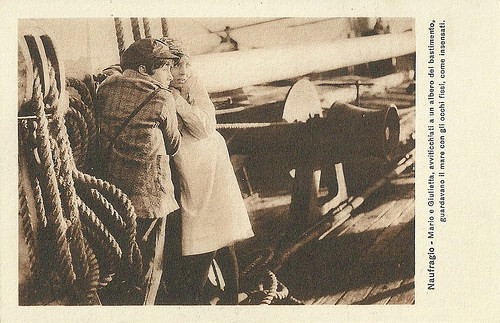
Italian postcard by Film Artistica Floria, Torino (Turin), no. 3404. Printed by Uff. Rev. St. Terni, 16-5-17. Caption: Curled up against the vessel's mast, Mario and Giulietta stared at the sea with fixed eyes, as if senseless.
An Orphan on a Sinking Ship
Ermanno Roveri played the Sicilian orphan Mario, who is repatriated from Liverpool to Sicily. On the boat he meets Giulietta (played by Ermanno’s sister, Lavinia Roveri), who has to return to her parents in Naples.
During a tempest the boat sinks and Mario offers his seat in the lifeboat to Giulietta. Mario drowns on the sinking ship.
Naufragio was a production of Gloria, the film company in Turin that also produced the first films of diva Lyda Borelli . Gloria produced a series of films based on the stories in Cuore (1886) by Edmondo De Amicis.
Roveri acted in many of these films, including Dagli Appennini alle Ande, Naufragio, Il piccolo patriota padovano and Il piccolo scrivano fiorentino.
Ermanno Roveri thus was one of the stars of Gloria. In 1913-1914 he had become famous as Frugolino, one of the comic child actors of the Cines company in Rome.
In the 1930s and 1940s Ermanno played in a dozen Italian films. He would continue to work in the theatre and incidentally in cinema or on television till his death in 1968.
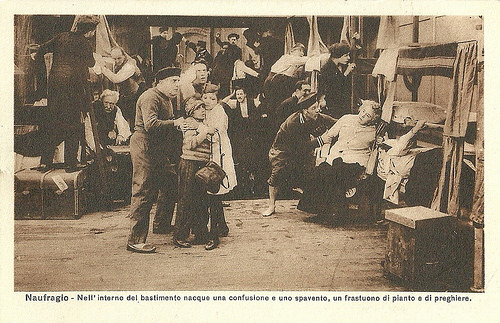
Italian postcard by Film Artistica Floria, Torino (Turin), no. 3404. Printed by Uff. Rev. St. Terni, 16-5-17. Caption: In the interior of the vessel a confusion started as well as fright, and an uproar of weeping and prayers.
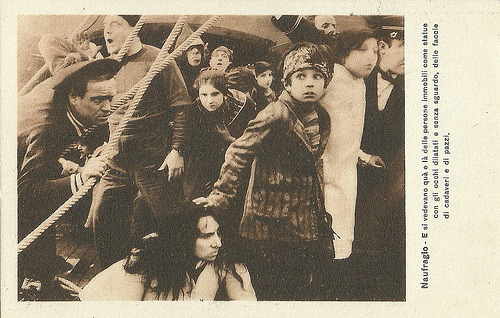
Italian postcard by Film Artistica Floria, Torino (Turin), no. 3404. Printed by Uff. Rev. St. Terni, 16-5-17. Caption: They saw all around them persons frozen like statues, with eyes wide open and with blank stares, with the faces of corpses and madmen.
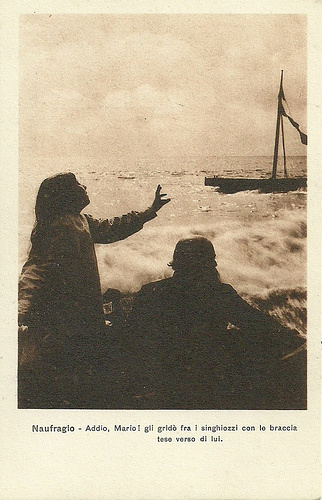
Italian postcard by Film Artistica Floria, Torino (Turin), no. 3404. Printed by Uff. Rev. St. Terni, 16-5-17. Caption: Goodbye, Mario!, she cried among her sobs with her arms extended towards him.
Sources: Vittorio Martinelli (Il Cinema Italiano 1916) and .

Italian postcard by Film Artistica Gloria, Torino (Turin), no. 3404. Printed by Uff. Rev. St. Terni, 16-5-17. Caption: He had the look of a boy who just came out of a big family misfortune.

Italian postcard by Film Artistica Floria, Torino (Turin), no. 3404. Printed by Uff. Rev. St. Terni, 16-5-17. Caption: Be cheerful, the Italian sailor cried to them, now a ballet starts!

Italian postcard by Film Artistica Floria, Torino (Turin), no. 3404. Printed by Uff. Rev. St. Terni, 16-5-17. Caption: Curled up against the vessel's mast, Mario and Giulietta stared at the sea with fixed eyes, as if senseless.
An Orphan on a Sinking Ship
Ermanno Roveri played the Sicilian orphan Mario, who is repatriated from Liverpool to Sicily. On the boat he meets Giulietta (played by Ermanno’s sister, Lavinia Roveri), who has to return to her parents in Naples.
During a tempest the boat sinks and Mario offers his seat in the lifeboat to Giulietta. Mario drowns on the sinking ship.
Naufragio was a production of Gloria, the film company in Turin that also produced the first films of diva Lyda Borelli . Gloria produced a series of films based on the stories in Cuore (1886) by Edmondo De Amicis.
Roveri acted in many of these films, including Dagli Appennini alle Ande, Naufragio, Il piccolo patriota padovano and Il piccolo scrivano fiorentino.
Ermanno Roveri thus was one of the stars of Gloria. In 1913-1914 he had become famous as Frugolino, one of the comic child actors of the Cines company in Rome.
In the 1930s and 1940s Ermanno played in a dozen Italian films. He would continue to work in the theatre and incidentally in cinema or on television till his death in 1968.

Italian postcard by Film Artistica Floria, Torino (Turin), no. 3404. Printed by Uff. Rev. St. Terni, 16-5-17. Caption: In the interior of the vessel a confusion started as well as fright, and an uproar of weeping and prayers.

Italian postcard by Film Artistica Floria, Torino (Turin), no. 3404. Printed by Uff. Rev. St. Terni, 16-5-17. Caption: They saw all around them persons frozen like statues, with eyes wide open and with blank stares, with the faces of corpses and madmen.

Italian postcard by Film Artistica Floria, Torino (Turin), no. 3404. Printed by Uff. Rev. St. Terni, 16-5-17. Caption: Goodbye, Mario!, she cried among her sobs with her arms extended towards him.
Sources: Vittorio Martinelli (Il Cinema Italiano 1916) and .
Published on August 16, 2017 22:00
August 15, 2017
Ernest Torrence
Big, burly Scottish-born character actor Ernest Torrence (1878-1933) appeared in many Hollywood films form 1916 on. A towering figure, he frequently played cold-eyed and imposing heavies, but played most of his bad guys with tongue firmly in cheek. Torrence’s films include including Tol'able David (1921) opposite Richard Barthelmess, Mantrap (1926) with Clara Bow, and Sherlock Holmes (1932) in one of his last roles as Holmes’s nemesis Professor Moriarty.
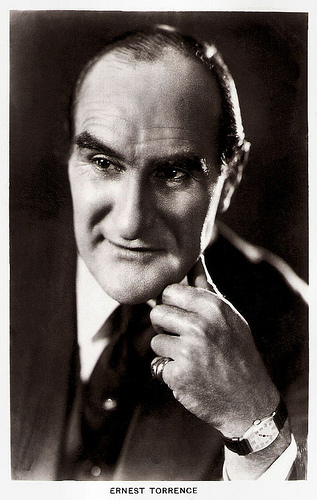
British postcard in the Picturegoer series, London, no. 167.
Moronic, twitch-eyed thief
Ernest Thayson Torrance-Thompson was born in 1978 to Colonel Henry Torrence Thayson and Jessie (née Bryce) in Edinburgh, Scotland. His younger brother would be the actor David Torrence.
As a child, Ernest was an exceptional pianist and operatic baritone and he graduated from the Stuttgart Conservatory and Edinburgh Academy before earning a scholarship at London's Royal Academy of Music.
He toured with the D'Oyly Carte Opera Company in such productions as The Emerald Isle (1901) and The Talk of the Town (1905) before disarming vocal problems set in and he was forced to abandon this career path.
Sometime prior to 1900, he changed the spelling of Torrance to Torrence and dropped the name Thomson. Both Ernest and his brother David Torrence went to America, in March 1911, directly from Scotland prior to the First World War.
Focusing instead on a purely acting career, Ernest and his brother developed into experienced players on the Broadway New York stage. Ernest received significant acclaim with Modest Suzanne in 1912, and a prominent role in The Night Boat in 1920 brought him to the attention of the early Hollywood filmmakers.
Torrence played the moronic, twitch-eyed thief Luke Hatburn in Tol'able David (Henry King, 1921) opposite Richard Barthelmess and made his mark as a cinema villain. He settled into films for the rest of his career and life.
He played Colleen Moore’s abusive husband in Broken Chains (Alan Holubar, 1922). Torrence gave a sympathetic portrayal of a grizzled old codger in the acclaimed classic Western The Covered Wagon (James Cruze, 1923) and gained attention from his role as Clopin, king of the beggars opposite Lon Chaney in The Hunchback of Notre Dame (Wallace Worsley, 1923).
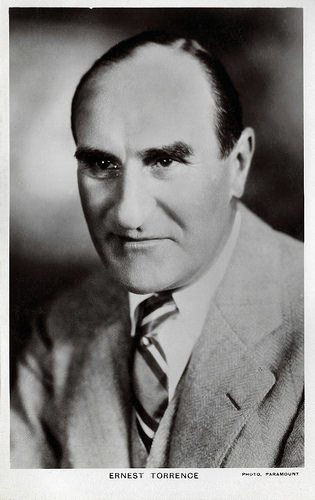
British postcard in the Picturegoer series, London, no. 167a. Photo: Paramount.
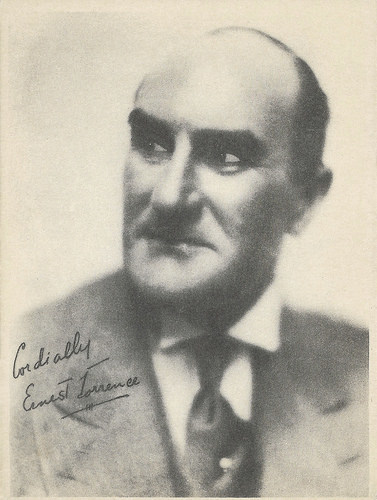
British autograph card.
One of the silent screen's finest arch villains
Ernest Torrence played an outrageous Captain Hook in Peter Pan (Herbert Brenon, 1924) opposite Betty Bronson as Peter Pan. Bob Eddwards at Find A Grave : “Walt Disney used Torrence as the model for Hook in his own 1953 animated version of Peter Pan.”
He played an Army General who escapes into the circus world and becomes a clown in The Side Show of Life (Herbert Brenon, 1924). In an offbeat bit of casting he paired up with Clara Bow in Mantrap (Victor Fleming, 1926), unusually as a gentle, bear-like backwoodsman in search of a wife.
He appeared in other silent film classics such as the epic The King of Kings (Cecil B. DeMille 1927) as Peter, and Steamboat Bill Jr. (Charles Reisner, 1928) as Buster Keaton 's steamboat captain father.
During the course of his twelve-year film career, Ernest Torrence made 49 films, both silent and sound films. Torrence made the transition into sound films very well, starring in the Western Fighting Caravans (Otto Brower, David Burton, 1931) with Gary Cooper and Lily Damita .
He was able to play a notable nemesis, Dr. Moriarty, to Clive Brook 's Sherlock in Sherlock Holmes (William K. Howard, 1932) in one of his last roles. Filming for I Cover the Waterfront (James Cruze, 1933), in which he starred as a New York smuggler opposite Ben Lyon and Claudette Colbert, had just been completed when he died suddenly on 15 May 1933.
He was only 54. While en route to Europe by ship, Torrence suffered an acute attack of gall stones and was rushed back to a New York hospital. He died of complications following surgery. Ernest Torrence was married to Elsie Reamer Bedbrook and he had one child, Ian Torrence.
Gary Brumburgh at IMDb : “He was the man you loved to hiss. This towering (6' 4"), highly imposing character star with cold, hollow, beady eyes and a huge, protruding snout would go on to become one of the silent screen's finest arch villains.”
Scene with Torrence and Clara Bow in Mantrap (Victor Fleming, 1926). Source: Jeff Alanson (YouTube).
Scene from Steamboat Bill Jr. (Charles Reisner, 1928). Source: Movies and Videos (YouTube).
Sources: (IMDb), Bobb Edwards (Find A Grave), Hal Erickson (AllMovie), Silent Hollywood.com, Wikipedia and .

British postcard in the Picturegoer series, London, no. 167.
Moronic, twitch-eyed thief
Ernest Thayson Torrance-Thompson was born in 1978 to Colonel Henry Torrence Thayson and Jessie (née Bryce) in Edinburgh, Scotland. His younger brother would be the actor David Torrence.
As a child, Ernest was an exceptional pianist and operatic baritone and he graduated from the Stuttgart Conservatory and Edinburgh Academy before earning a scholarship at London's Royal Academy of Music.
He toured with the D'Oyly Carte Opera Company in such productions as The Emerald Isle (1901) and The Talk of the Town (1905) before disarming vocal problems set in and he was forced to abandon this career path.
Sometime prior to 1900, he changed the spelling of Torrance to Torrence and dropped the name Thomson. Both Ernest and his brother David Torrence went to America, in March 1911, directly from Scotland prior to the First World War.
Focusing instead on a purely acting career, Ernest and his brother developed into experienced players on the Broadway New York stage. Ernest received significant acclaim with Modest Suzanne in 1912, and a prominent role in The Night Boat in 1920 brought him to the attention of the early Hollywood filmmakers.
Torrence played the moronic, twitch-eyed thief Luke Hatburn in Tol'able David (Henry King, 1921) opposite Richard Barthelmess and made his mark as a cinema villain. He settled into films for the rest of his career and life.
He played Colleen Moore’s abusive husband in Broken Chains (Alan Holubar, 1922). Torrence gave a sympathetic portrayal of a grizzled old codger in the acclaimed classic Western The Covered Wagon (James Cruze, 1923) and gained attention from his role as Clopin, king of the beggars opposite Lon Chaney in The Hunchback of Notre Dame (Wallace Worsley, 1923).

British postcard in the Picturegoer series, London, no. 167a. Photo: Paramount.

British autograph card.
One of the silent screen's finest arch villains
Ernest Torrence played an outrageous Captain Hook in Peter Pan (Herbert Brenon, 1924) opposite Betty Bronson as Peter Pan. Bob Eddwards at Find A Grave : “Walt Disney used Torrence as the model for Hook in his own 1953 animated version of Peter Pan.”
He played an Army General who escapes into the circus world and becomes a clown in The Side Show of Life (Herbert Brenon, 1924). In an offbeat bit of casting he paired up with Clara Bow in Mantrap (Victor Fleming, 1926), unusually as a gentle, bear-like backwoodsman in search of a wife.
He appeared in other silent film classics such as the epic The King of Kings (Cecil B. DeMille 1927) as Peter, and Steamboat Bill Jr. (Charles Reisner, 1928) as Buster Keaton 's steamboat captain father.
During the course of his twelve-year film career, Ernest Torrence made 49 films, both silent and sound films. Torrence made the transition into sound films very well, starring in the Western Fighting Caravans (Otto Brower, David Burton, 1931) with Gary Cooper and Lily Damita .
He was able to play a notable nemesis, Dr. Moriarty, to Clive Brook 's Sherlock in Sherlock Holmes (William K. Howard, 1932) in one of his last roles. Filming for I Cover the Waterfront (James Cruze, 1933), in which he starred as a New York smuggler opposite Ben Lyon and Claudette Colbert, had just been completed when he died suddenly on 15 May 1933.
He was only 54. While en route to Europe by ship, Torrence suffered an acute attack of gall stones and was rushed back to a New York hospital. He died of complications following surgery. Ernest Torrence was married to Elsie Reamer Bedbrook and he had one child, Ian Torrence.
Gary Brumburgh at IMDb : “He was the man you loved to hiss. This towering (6' 4"), highly imposing character star with cold, hollow, beady eyes and a huge, protruding snout would go on to become one of the silent screen's finest arch villains.”
Scene with Torrence and Clara Bow in Mantrap (Victor Fleming, 1926). Source: Jeff Alanson (YouTube).
Scene from Steamboat Bill Jr. (Charles Reisner, 1928). Source: Movies and Videos (YouTube).
Sources: (IMDb), Bobb Edwards (Find A Grave), Hal Erickson (AllMovie), Silent Hollywood.com, Wikipedia and .
Published on August 15, 2017 22:00
August 14, 2017
Christine Norden
Blonde, green-eyed bombshell Christine Norden (1924-1988) was Britain’s first post-war screen sex goddess. The ex-dancer, actress and singer won in the late 1940s and early 1950s two prestigious film awards, but she was best known for her 39 inch breasts and her racy image.
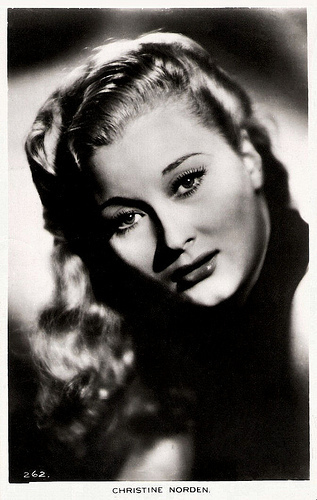
British postcard, no. 262.
Seven-year Contract
Christine Norden was born Mary Lydia Thornton in Sunderland, Great Britain on Christmas day in 1924. She was the daughter of Charles Hunter; a bus driver, and Catherine (McAloon) Thornton.
Christine performed as a dancer and a singer since her teens. She made her London stage debut as Molly Thornton in Tell the World in 1942. She became the first entertainer to land on Normandy beaches in 1944 to perform for Allied troops after D-Day.
The story goes that she was ‘discovered’ in 1947 by agents of the distinguished film mogul Sir Alexander Korda while waiting outside a theatre ticket line. Korda promptly signed her to a seven-year contract, and Christine also became his mistress.
She made her film debut in the melodrama Night Beat (Harold Huth, 1947) as an alluring temptress. She was known for her 39 inch breasts which made her a prime pin-up attraction.
Korda placed her in stark, dark-edged films as fetching, sometimes singing femmes, appearing in a surprising number of quality films including Mine Own Executioner (Anthony Kimmins, 1947) opposite Burgess Meredith and An Ideal Husband (Alexander Korda, 1948) starring Paulette Goddard.
She won a Venice Festival award for most promising actress in 1947, and the British National Film Award in 1949 for her performance in Saints and Sinners (Leslie Arliss, 1949).
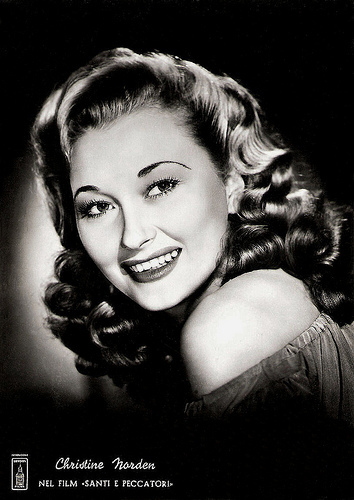
Italian postcard by Rotalfoto, Milano (Milan), no. 2. Photo: London Films. Publicity still for Saints and Sinners (1949).
Topless on Broadway
By the early 1950s the film career of Christine Norden was over. Her last British film was the thriller The Black Widow (Vernon Sewell, 1951), and the following year she went to New York.
Her Broadway debut was in the musical Tenderloin in 1960 and later she appeared in such productions as Marat/Sade. She was the first actress to appear topless on Broadway in Scuba Duba (1967).
Although she became an American citizen, she returned to London in 1979 and acted in plays, films and television shows during the 1980s, including the musical Little Shop of Horrors (Frank Oz, 1988) and in an episode of the popular TV series Inspector Morse (1987).
Christine Norden admitted to many affairs (both men and women) over the years, and she is reported to have had affairs with Richard Burton and Ava Gardner , along with Prince Philip.
She was married five times (including with director Jack Clayton). One of the craters of the planet Venus has been named after her as a tribute to her being a ‘forerunner of the modern sex symbol.’ Her last husband, George Heselden, a retired mathematician, developed and named a mathematical formula in her honour.
After a bypass surgery, she died of pneumonia in 1988, in Isleworth, England. She was 63, and had one child, Michael Glenn, from her first marriage. Her memoirs were discovered after she died, but were considered too racy to be published at the time. Her friend, and royal biographer, Michael Thornton, to whom they were left, has now made parts of the story public.
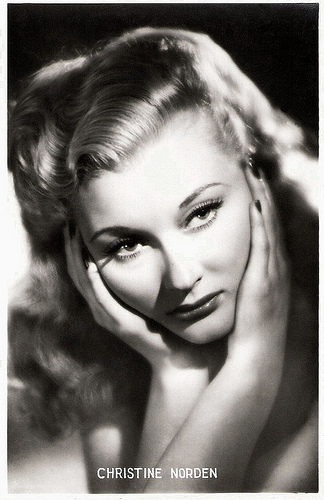
British postcard, no. F.S. 55.
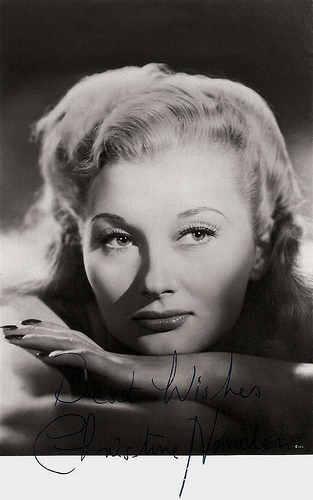
British autograph card.
Sources: (IMDb), Sandra Brennan (AllMovie), The New York Times, Film Reference, Wikipedia and .

British postcard, no. 262.
Seven-year Contract
Christine Norden was born Mary Lydia Thornton in Sunderland, Great Britain on Christmas day in 1924. She was the daughter of Charles Hunter; a bus driver, and Catherine (McAloon) Thornton.
Christine performed as a dancer and a singer since her teens. She made her London stage debut as Molly Thornton in Tell the World in 1942. She became the first entertainer to land on Normandy beaches in 1944 to perform for Allied troops after D-Day.
The story goes that she was ‘discovered’ in 1947 by agents of the distinguished film mogul Sir Alexander Korda while waiting outside a theatre ticket line. Korda promptly signed her to a seven-year contract, and Christine also became his mistress.
She made her film debut in the melodrama Night Beat (Harold Huth, 1947) as an alluring temptress. She was known for her 39 inch breasts which made her a prime pin-up attraction.
Korda placed her in stark, dark-edged films as fetching, sometimes singing femmes, appearing in a surprising number of quality films including Mine Own Executioner (Anthony Kimmins, 1947) opposite Burgess Meredith and An Ideal Husband (Alexander Korda, 1948) starring Paulette Goddard.
She won a Venice Festival award for most promising actress in 1947, and the British National Film Award in 1949 for her performance in Saints and Sinners (Leslie Arliss, 1949).

Italian postcard by Rotalfoto, Milano (Milan), no. 2. Photo: London Films. Publicity still for Saints and Sinners (1949).
Topless on Broadway
By the early 1950s the film career of Christine Norden was over. Her last British film was the thriller The Black Widow (Vernon Sewell, 1951), and the following year she went to New York.
Her Broadway debut was in the musical Tenderloin in 1960 and later she appeared in such productions as Marat/Sade. She was the first actress to appear topless on Broadway in Scuba Duba (1967).
Although she became an American citizen, she returned to London in 1979 and acted in plays, films and television shows during the 1980s, including the musical Little Shop of Horrors (Frank Oz, 1988) and in an episode of the popular TV series Inspector Morse (1987).
Christine Norden admitted to many affairs (both men and women) over the years, and she is reported to have had affairs with Richard Burton and Ava Gardner , along with Prince Philip.
She was married five times (including with director Jack Clayton). One of the craters of the planet Venus has been named after her as a tribute to her being a ‘forerunner of the modern sex symbol.’ Her last husband, George Heselden, a retired mathematician, developed and named a mathematical formula in her honour.
After a bypass surgery, she died of pneumonia in 1988, in Isleworth, England. She was 63, and had one child, Michael Glenn, from her first marriage. Her memoirs were discovered after she died, but were considered too racy to be published at the time. Her friend, and royal biographer, Michael Thornton, to whom they were left, has now made parts of the story public.

British postcard, no. F.S. 55.

British autograph card.
Sources: (IMDb), Sandra Brennan (AllMovie), The New York Times, Film Reference, Wikipedia and .
Published on August 14, 2017 22:00
August 13, 2017
Imperio Argentina
For the new issue of the international magazine The Italianist, film historian Ivo Blom wrote an article on the production of the film Tosca (1941), a curious and intriguing case in film history. It was originally begun by French director Jean Renoir, but finished by his German screenwriter-turned-director Carl Koch. Koch’s wife Lotte Reiniger and the young Luchino Visconti contributed to the film, while its producer was the grand old man of Italian silent film, Arturo Ambrosio. But the leading role of Tosca was played by only one person, the enigmatic Imperio Argentina (1906-2003). Although the famous actress and singer was born in Buenos Aires, Argentina, was successful all over South America and worked in Spain, France, Italy and Germany, she was a Spanish citizen.
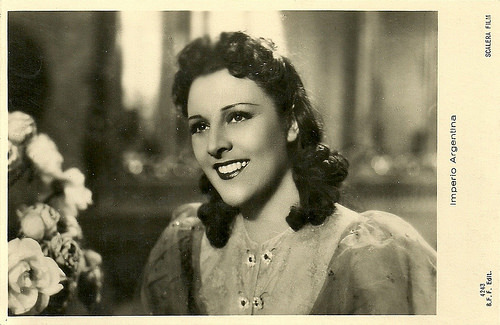
Italian postcard by Ballerini & Fratini Firenze Editori, no. 4248. Photo: Scalera Film. Publicity still of Imperio Argentina in Tosca (Carl Koch, 1941).
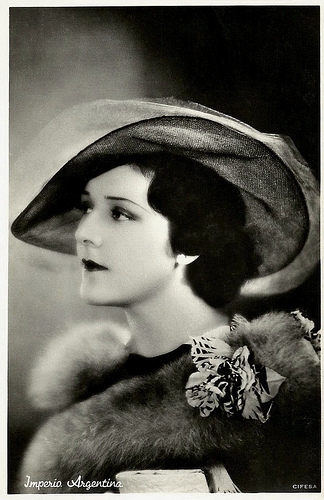
Dutch postcard by M. B. & Z. (M. Bonnist & Zonen, Amsterdam), no. 199. Photo: Cifesa (Cifesa was a big Spanish film distribution company between the mid-1930s and the early 1960s.)
Petite Imperio
Imperio Argentina was born Magdalena Nile del Río in 1906 in San Telmo, the tango district of Buenos Aires. Her Spanish parents, guitar player Antonio Nile and actress Rosario del Río, were on tour in Argentine.
Until the age of 12 she lived in Malaga, where she studied dance. Thanks to Pastora Imperio, she debuted at the age of 12 at the comedy theatre of Buenos Aires. Imperio called her 'Petite Imperio', her artistic name in those years, when she was successful all over South America.
When she came back to Spain in 1926, she adopted the artistic name of Imperio Argentina, singing in the main theatres of the country. Film director Florián Rey discovered her at the Romea theatre in Madrid and enabled her to play in the silent film La Hermana San Sulpicio/Sister San Sulpicio (Florián Rey, 1927).
Eventually she also married Rey, who was the first of her three husbands. In Spain and Germany, Argentina performed in the late silent Corazones sin rumbo/Herzen ohne Ziel/Hearts Without Soul (Benito Perojo, Gustav Ucicky, 1928), which costarred Betty Bird and Livio Pavanelli .
After signing a contract with Paramount Pictures, she worked in Paris with the best directors and actors of the moment. Her films included Su noche de bodas/Her Wedding Night (Louis Mercanton, Floriàn Rey, 1931) and Lo mejor es reir/Laughter (E.W. Emo, Floriàn Rey, 1931) with Tony D'Algy .
At Paramount she worked with Carlos Gardel in the short La casa es seria/Love Me Tonight (Lucien Jacquelux, 1931), which is considered as lost, and Melodía de Arrabal/Suburban Melody (Louis Gasnier, 1932), singing rare duets with him.
In 1934 Argentina returned to Spain, where, thanks to her cooperation with Rey, she became a star and obtained her greatest successes in folklorist films as the sound version of Hermana de San Sulpicio/Sister San Sulpicio (Floriàn Rey, 1934), Nobleza Baturra/Aragonese Virtue (Floriàn Rey, 1935), and Morena Clara/Dark and Bright (Floriàn Rey, 1936).
Adolf Hitler asked her to play in a film about Lola Montes, which she declined but instead she played in both the Spanish and the German version of Carmen, la de Triana/Andalusische Nächte (Florian Rey, Herbert Maisch, 1938), shot around Malaga. In the German version Friedrich Benfer (a.k.a. Enrico Benfer ) costarred as Don José, while in the Spanish version Rafael Rivelles played this part.
Imperio Argentina is said to have had an affair with Rafael Rivelles before she had divorced her second husband Ramón Baillío. Her divorce caused a scanald, as she was married for the Catholic church.
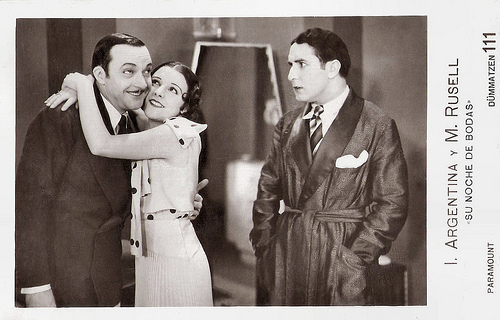
Spanish postcard by Dümmatzen, no. 111. Photo: Paramount. Publicity still of Imperio Argentina, Manuel Russell and Pepe Romeu in Su noche de bodas/Her Wedding Night (Louis Mercanton, Florián Rey, 1931).
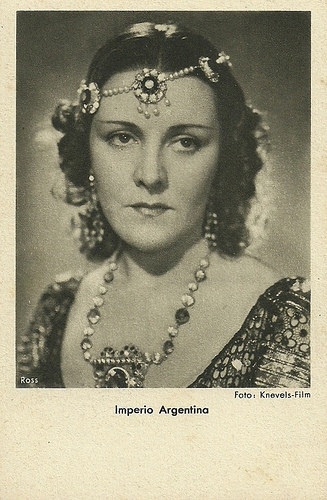
German postcard by Ross Verlag. Photo: Knevels-Film. Imperio Argentina, wearing the attire of La canción de Aixa/Song of Aixa (Florián Rey, 1939).
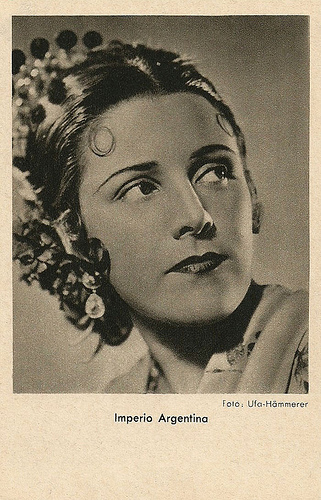
German postcard. Photo: Ufa / Hämmerer.
Paseo de la Fama
In 1940 Imperio Argentina travelled to Rome to star opposite Rossano Brazzi in Tosca/The Story of Tosca (Carlo a.k.a. Carl Koch, 1941), an adaptation of the story by Victorien Sardou. The film was originally directed by Jean Renoir, but when war between France and Italy was at hand and Renoir was knocked down by fascists one day, he fled to France and his assistant Carl Koch took over directing.
In his memoirs, Michel Simon , who played her antagonist Scarpia in the film, recalls how he rehearsed the rape scene of Tosca too vividly, unveiling one of her breasts. Fascinated, he tried the same the next day, but Imperio had taken measures, firmly tying up her robe.
The film was partly shot on location, at the Castel Sant’Angelo, the Palatine Hill and in front of the Palazzo Farnese (the French embassy). A young Luchino Visconti collaborated as a first assistant and learned the tricks of the trade here.
In the 1940s, Imperio also worked with director Benito Perojo at the films Goyescas (1942), Bambú/Bamboo (1945), La maja de los cantares/The Songstress (1946) and La copla de la Dolores/Song of Dolores (1951) with Lola Beltrán.
In the 1950s she focused on big musical shows while in the 1960s she did Ama Rosa (León Klimovsky, 1960) and Con el viento Solano/With the East Wind (Mario Camus, 1966) as the mother of Antonio Gades. After years of little activity she was rediscovered at Festival Internacional de Cine in San Sebastián. From then on a new golden age started, full of honors.
Argentina became a citizen of Spain in 1999. In the following decades, she appeared in Tata Mía/Dear Nanny (José Luis Borau, 1986) opposite Carmen Maura and in El polizón de Ulises/The stowaway of the Ulises (Javier Aguirre, 1987), her last film. She also performed in the stage play of the Expo 92, Azabache.
In 1996 she was elected 'pregonera' at the Festa del Pilar at Saragozza, to celebrate the centenary of the cinema. In 2001 she published her memoirs, Malena Clara, written by Pedro Villora.
At the age of 92, Imperio Argentina died of natural causes in 2003 in her house in Torremolinos in Andalucia. She lies buried nearby at Benalmádena near Málaga. In 2011 she was honoured with a star in the Spanish Walk of Fame, the Paseo de la Fama in Madrid. In 1994 she already was honoured as 'Ciudadano Ilustre de la Ciudad de Buenos Aires' (Illustrious Citizen of the City of Buenos Aires).
Scene with Imperio Argentina in Carmen la de Triana (Florían Rey, 1938) singing Los piconeros. Source: Canta Roable (YouTube).
Long scene from Tosca/The Story of Tosca (Carl Koch, 1941). Source: Otello Bailor (YouTube).
Sources: (IMDb), Wikipedia (English, German, Italian and Spanish), and .

Italian postcard by Ballerini & Fratini Firenze Editori, no. 4248. Photo: Scalera Film. Publicity still of Imperio Argentina in Tosca (Carl Koch, 1941).

Dutch postcard by M. B. & Z. (M. Bonnist & Zonen, Amsterdam), no. 199. Photo: Cifesa (Cifesa was a big Spanish film distribution company between the mid-1930s and the early 1960s.)
Petite Imperio
Imperio Argentina was born Magdalena Nile del Río in 1906 in San Telmo, the tango district of Buenos Aires. Her Spanish parents, guitar player Antonio Nile and actress Rosario del Río, were on tour in Argentine.
Until the age of 12 she lived in Malaga, where she studied dance. Thanks to Pastora Imperio, she debuted at the age of 12 at the comedy theatre of Buenos Aires. Imperio called her 'Petite Imperio', her artistic name in those years, when she was successful all over South America.
When she came back to Spain in 1926, she adopted the artistic name of Imperio Argentina, singing in the main theatres of the country. Film director Florián Rey discovered her at the Romea theatre in Madrid and enabled her to play in the silent film La Hermana San Sulpicio/Sister San Sulpicio (Florián Rey, 1927).
Eventually she also married Rey, who was the first of her three husbands. In Spain and Germany, Argentina performed in the late silent Corazones sin rumbo/Herzen ohne Ziel/Hearts Without Soul (Benito Perojo, Gustav Ucicky, 1928), which costarred Betty Bird and Livio Pavanelli .
After signing a contract with Paramount Pictures, she worked in Paris with the best directors and actors of the moment. Her films included Su noche de bodas/Her Wedding Night (Louis Mercanton, Floriàn Rey, 1931) and Lo mejor es reir/Laughter (E.W. Emo, Floriàn Rey, 1931) with Tony D'Algy .
At Paramount she worked with Carlos Gardel in the short La casa es seria/Love Me Tonight (Lucien Jacquelux, 1931), which is considered as lost, and Melodía de Arrabal/Suburban Melody (Louis Gasnier, 1932), singing rare duets with him.
In 1934 Argentina returned to Spain, where, thanks to her cooperation with Rey, she became a star and obtained her greatest successes in folklorist films as the sound version of Hermana de San Sulpicio/Sister San Sulpicio (Floriàn Rey, 1934), Nobleza Baturra/Aragonese Virtue (Floriàn Rey, 1935), and Morena Clara/Dark and Bright (Floriàn Rey, 1936).
Adolf Hitler asked her to play in a film about Lola Montes, which she declined but instead she played in both the Spanish and the German version of Carmen, la de Triana/Andalusische Nächte (Florian Rey, Herbert Maisch, 1938), shot around Malaga. In the German version Friedrich Benfer (a.k.a. Enrico Benfer ) costarred as Don José, while in the Spanish version Rafael Rivelles played this part.
Imperio Argentina is said to have had an affair with Rafael Rivelles before she had divorced her second husband Ramón Baillío. Her divorce caused a scanald, as she was married for the Catholic church.

Spanish postcard by Dümmatzen, no. 111. Photo: Paramount. Publicity still of Imperio Argentina, Manuel Russell and Pepe Romeu in Su noche de bodas/Her Wedding Night (Louis Mercanton, Florián Rey, 1931).

German postcard by Ross Verlag. Photo: Knevels-Film. Imperio Argentina, wearing the attire of La canción de Aixa/Song of Aixa (Florián Rey, 1939).

German postcard. Photo: Ufa / Hämmerer.
Paseo de la Fama
In 1940 Imperio Argentina travelled to Rome to star opposite Rossano Brazzi in Tosca/The Story of Tosca (Carlo a.k.a. Carl Koch, 1941), an adaptation of the story by Victorien Sardou. The film was originally directed by Jean Renoir, but when war between France and Italy was at hand and Renoir was knocked down by fascists one day, he fled to France and his assistant Carl Koch took over directing.
In his memoirs, Michel Simon , who played her antagonist Scarpia in the film, recalls how he rehearsed the rape scene of Tosca too vividly, unveiling one of her breasts. Fascinated, he tried the same the next day, but Imperio had taken measures, firmly tying up her robe.
The film was partly shot on location, at the Castel Sant’Angelo, the Palatine Hill and in front of the Palazzo Farnese (the French embassy). A young Luchino Visconti collaborated as a first assistant and learned the tricks of the trade here.
In the 1940s, Imperio also worked with director Benito Perojo at the films Goyescas (1942), Bambú/Bamboo (1945), La maja de los cantares/The Songstress (1946) and La copla de la Dolores/Song of Dolores (1951) with Lola Beltrán.
In the 1950s she focused on big musical shows while in the 1960s she did Ama Rosa (León Klimovsky, 1960) and Con el viento Solano/With the East Wind (Mario Camus, 1966) as the mother of Antonio Gades. After years of little activity she was rediscovered at Festival Internacional de Cine in San Sebastián. From then on a new golden age started, full of honors.
Argentina became a citizen of Spain in 1999. In the following decades, she appeared in Tata Mía/Dear Nanny (José Luis Borau, 1986) opposite Carmen Maura and in El polizón de Ulises/The stowaway of the Ulises (Javier Aguirre, 1987), her last film. She also performed in the stage play of the Expo 92, Azabache.
In 1996 she was elected 'pregonera' at the Festa del Pilar at Saragozza, to celebrate the centenary of the cinema. In 2001 she published her memoirs, Malena Clara, written by Pedro Villora.
At the age of 92, Imperio Argentina died of natural causes in 2003 in her house in Torremolinos in Andalucia. She lies buried nearby at Benalmádena near Málaga. In 2011 she was honoured with a star in the Spanish Walk of Fame, the Paseo de la Fama in Madrid. In 1994 she already was honoured as 'Ciudadano Ilustre de la Ciudad de Buenos Aires' (Illustrious Citizen of the City of Buenos Aires).
Scene with Imperio Argentina in Carmen la de Triana (Florían Rey, 1938) singing Los piconeros. Source: Canta Roable (YouTube).
Long scene from Tosca/The Story of Tosca (Carl Koch, 1941). Source: Otello Bailor (YouTube).
Sources: (IMDb), Wikipedia (English, German, Italian and Spanish), and .
Published on August 13, 2017 22:00
August 12, 2017
Rose Liechtenstein
Rose Liechtenstein (1887-1955) was a German theatre and film actress of the silent film era. Later she became 'the Adele Sandrock of the Israeli'.
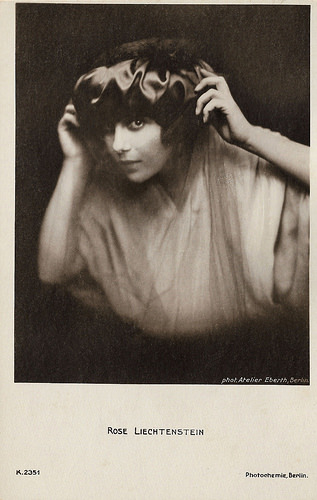
German postcard by Photochemie, Berlin, no. K. 2351. Photo: Atelier Eberth, Berlin.
Fritz Lang
Rose Liechtenstein, also credited as Rosa Liechtenstein, Rose Lichtenstein and Rosa Lichtenstein, was born as Rosa Liechtenstein in 1887 in Landsberg, Germany or in Wronke, Russian Germany (now: Wronki in the Szamotuły County, western-central Poland). The sources differ about her birthtown.
She received her training at the Marie-Seebach-Schule before she went to Meiningen in 1909. There followed engagements in Düsseldorf, Mannheim, Berlin and New York. She worked with such famous directors as Erwin Piscator and Max Reinhardt. In 1915 she played at front theatres in the German-occupied areas of Belgium and France.
From 1916 she was also active in the film business. She starred in such silent melodramas as Arme Eva Maria/Poor Eva Maria (Joe May, 1916) at the side of Mia May , Der eiserne Wille/The Iron Will (Adolf Gärtner, 1917) starring Albert Bassermann , and the silent Detective film Der Würger der Welt/The creeper of the world(E. A. Dupont, 1919) with Max Landa .
Rose Liechtenstein appeared for Fritz Lang in small parts in Die Nibelungen, 2.Teil: Kriemhild's Revenge/Die Nibelungen: Kriemhild's Revenge (1924), Metropolis (1926) and in his first sound film M - Eine Stadt sucht eine Mörder/M - A city looks for a murderer (1931). It was her last film before her emigration.
In addition to her stage work, Liechtenstein was also cast as a spokesman for radio play productions at the Berliner Funk-Stunde in 1929. The rise of the National Socialists caused the artist of Jewish origin to flee to Palestine in 1936.
In 1944, she was one of the founders of the famous Theatron Kameri in Tel Aviv, where she played more than 25 roles. She became' the Adele Sandrock of the Israeli', according to author Rudolf Frank.
In 1955, Rose Liechtenstein died 68 years old in Tel Aviv.

German postcard by Ross Verlag, Berlin, no. 677/2. Photo: Decla-Ufa-Film. Kriemhild ( Margarete Schön ) at the spring where Siegfried died in Die Nibelungen, 2.Teil: Kriemhild's Revenge/Die Nibelungen: Kriemhild's Revenge (Fritz Lang, 1924).
Sources: Stephanie d'Heil (Steffi-line - German), Wikipedia and .

German postcard by Photochemie, Berlin, no. K. 2351. Photo: Atelier Eberth, Berlin.
Fritz Lang
Rose Liechtenstein, also credited as Rosa Liechtenstein, Rose Lichtenstein and Rosa Lichtenstein, was born as Rosa Liechtenstein in 1887 in Landsberg, Germany or in Wronke, Russian Germany (now: Wronki in the Szamotuły County, western-central Poland). The sources differ about her birthtown.
She received her training at the Marie-Seebach-Schule before she went to Meiningen in 1909. There followed engagements in Düsseldorf, Mannheim, Berlin and New York. She worked with such famous directors as Erwin Piscator and Max Reinhardt. In 1915 she played at front theatres in the German-occupied areas of Belgium and France.
From 1916 she was also active in the film business. She starred in such silent melodramas as Arme Eva Maria/Poor Eva Maria (Joe May, 1916) at the side of Mia May , Der eiserne Wille/The Iron Will (Adolf Gärtner, 1917) starring Albert Bassermann , and the silent Detective film Der Würger der Welt/The creeper of the world(E. A. Dupont, 1919) with Max Landa .
Rose Liechtenstein appeared for Fritz Lang in small parts in Die Nibelungen, 2.Teil: Kriemhild's Revenge/Die Nibelungen: Kriemhild's Revenge (1924), Metropolis (1926) and in his first sound film M - Eine Stadt sucht eine Mörder/M - A city looks for a murderer (1931). It was her last film before her emigration.
In addition to her stage work, Liechtenstein was also cast as a spokesman for radio play productions at the Berliner Funk-Stunde in 1929. The rise of the National Socialists caused the artist of Jewish origin to flee to Palestine in 1936.
In 1944, she was one of the founders of the famous Theatron Kameri in Tel Aviv, where she played more than 25 roles. She became' the Adele Sandrock of the Israeli', according to author Rudolf Frank.
In 1955, Rose Liechtenstein died 68 years old in Tel Aviv.

German postcard by Ross Verlag, Berlin, no. 677/2. Photo: Decla-Ufa-Film. Kriemhild ( Margarete Schön ) at the spring where Siegfried died in Die Nibelungen, 2.Teil: Kriemhild's Revenge/Die Nibelungen: Kriemhild's Revenge (Fritz Lang, 1924).
Sources: Stephanie d'Heil (Steffi-line - German), Wikipedia and .
Published on August 12, 2017 22:00
August 11, 2017
Vom Werden deutscher Filmkunst, Part 2
We continue our series of posts on the collectors cards Vom Werden deutscher Filmkunst which Ross Verlag produced for the 'Cigaretten-Bilderdienst', Altona-Bahrenfeld in 1935. The cards were included with cigarette packs. Last week the pictures showed the first stars of the early German silent cinema, like Asta Nielsen, Wanda Treumann and Viggo Larsen. After the First World War new faces joined them and also such directors as Ernst Lubitsch and Fritz Lang started their careers. So, meet today Mia May as the Mistress of the World, meet Lil Dagover, Werner Krauss, Harry Liedtke and meet the very young Hans Albers.
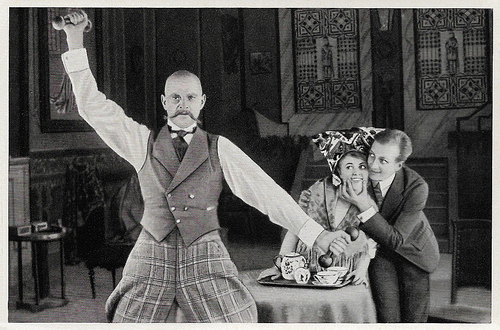
Paul Westermeier, Hanne Brinkmann and Hans Albers in Baroneßchen auf Strafurlaub (1917). German collectors card by Ross Verlag in the series Vom Werden deutscher Filmkunst - Der Stumme Film, picture no. 38, group 43. Photo: publicity still for Baroneßchen auf Strafurlaub/Little Baroness on Punishment Holiday (Otto Rippert, 1917). Caption: Paul Westermeier 'works out', Hans Albers - in a small secondary role - is allowed to pinch Hanne Brinkmann in the cheek.
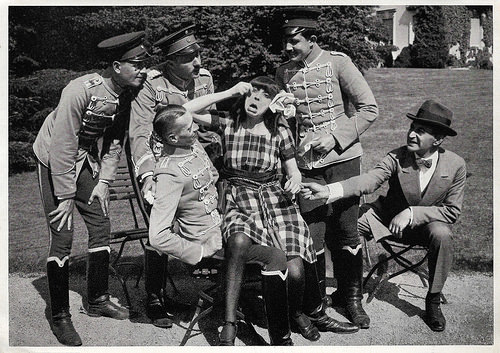
Asta Nielsen , Bruno Kastner and Max Landa in Engelein (1914). German collectors card by Ross Verlag in the series Vom Werden deutscher Filmkunst - Der Stumme Film, picture no. 42, group 40. Photo: Ufa. Publicity still for Engelein/Little Angel (Urban Gad, 1914).
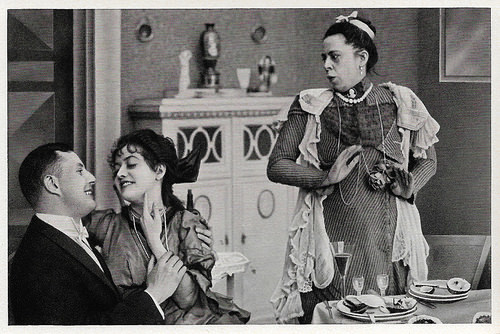
Bruno Kastner , Dorrit Weixler and Frida Richard in Dorittchens Vergnügungsreise (1916). German collectors card by Ross Verlag in the series Vom Werden deutscher Filmkunst - Der Stumme Film, picture no. 45, group 43. Photo: Tobias-Film. Publicity still for Dorittchens Vergnügungsreise/Little Dorrit's Pleasure Trip (Paul Heidemann, 1916).
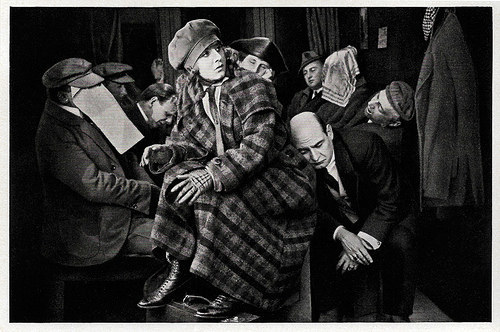
Ossi Oswalda in Kakadu und Kiebitz (1920). German collectors card by Ross Verlag in the series Vom Werden deutscher Filmkunst - Der Stumme Film, picture no. 46, group 43. Photo: Ufa. Publicity still for Kakadu und Kiebitz/Kakadu and Kiebitz (Erich Schönfelder, 1920).
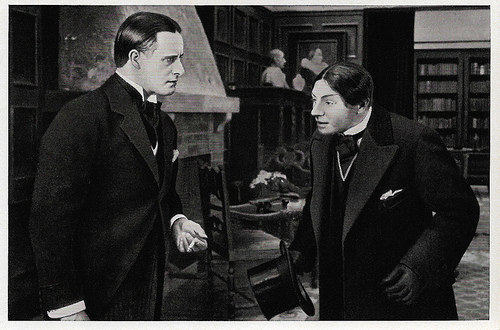
Carl Auen in Der heulende Wolf (1919). German collectors card by Ross Verlag in the series Vom Werden deutscher Filmkunst - Der Stumme Film, picture no. 50, group 43. Photo: Ufa. Publicity still for Der heulende Wolf/The Crying Wolf (Leo Lasko, 1919). Caption: " Carl Auen as detective in The Crying Wolf".
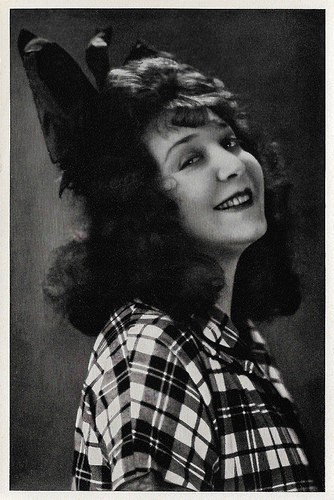
Erika Glässner . German collectors card by Ross Verlag in the series Vom Werden deutscher Filmkunst - Der Stumme Film, picture no. 52, group 43. Photo: Alex Binder. Caption: " Erika Glässner , the Backfisch (young flapper) from West Berlin in many Aufklärungsfilmen (educational films on social issues)."
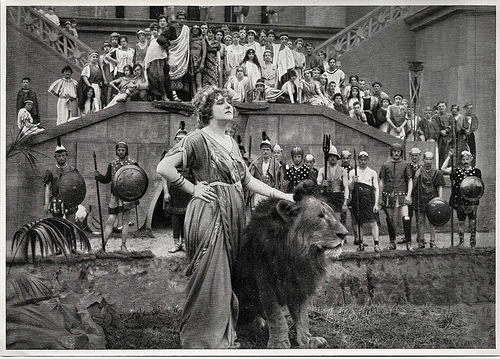
Mia May in Veritas Vincit (1919). German collectors card by Ross Verlag in the series Vom Werden deutscher Filmkunst - Der Stumme Film, picture no. 55, group 40. Photo: Ufa. Publicity still for Veritas Vincit (Joe May, 1919).
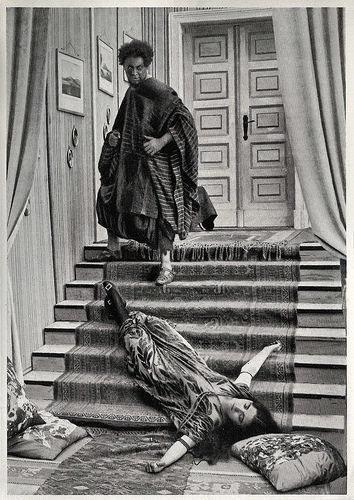
Emil Jannings and Pola Negri in Die Augen der Mumie Ma (1918). German collectors card by Ross Verlag in the series Vom Werden deutscher Filmkunst - Der Stumme Film, picture no. 58, group 40. Photo: Ufa. Publicity still for Die Augen der Mumie Ma/The Eyes of the Mummy (Ernst Lubitsch, 1918).
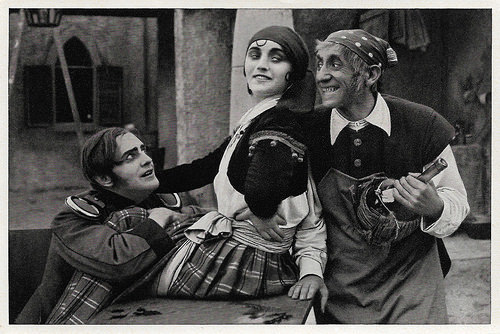
Harry Liedtke and Pola Negri in Carmen (1918). German collectors card by Ross Verlag in the series Vom Werden deutscher Filmkunst - Der Stumme Film, picture no, 59, group 43. Photo: Ufa. Publicity still for Carmen (Ernst Lubitsch, 1918).
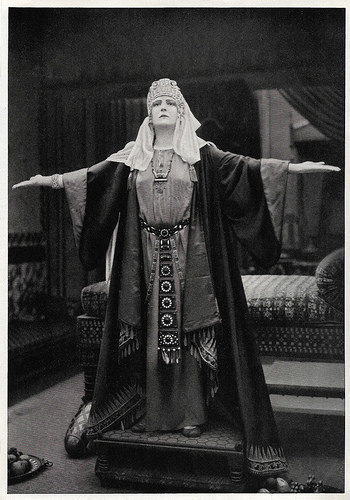
Mia May in Herrin der Welt (1919-1920). German collectors card by Ross Verlag in the series Vom Werden deutscher Filmkunst - Der Stumme Film, picture no. 62, group 40. Photo: Ufa. Publicity still for Die Herrin der Welt/Mistress of the World (Joe May and others, 1919).
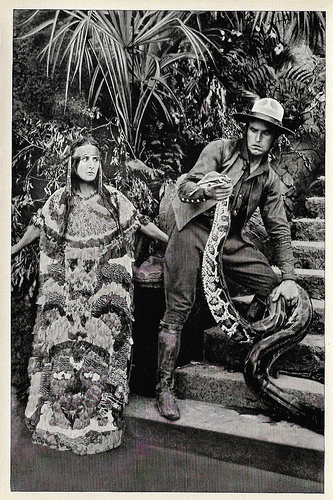
Lil Dagover and Carl de Vogt in Die Spinnen (1919). German photocard for the album Vom Werden deutscher Filmkunst. Teil I. Der stumme Film by Ross Verlag, picture no. 63. Photo: Decla-Film. Publicity still for Die Spinnen/The Spiders (Fritz Lang, 1919-1920).
Georg Alexander , Harry Liedtke and Hubert von Meyerinck in Der Mann ohne Namen (1921). German collectors card by Ross Verlag in the series Vom Werden deutscher Filmkunst - Der Stumme Film, picture no. 64, group 43. Photo: Ufa. Publicity still for Der Mann ohne Nahmen/The Man Without a Name (Georg Jacoby, 1921).
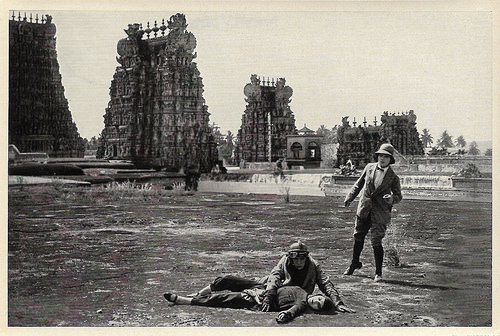
Ellen Richter , Anton Pointner and Hans Brausewetter in Der flug um den Erdball (1925). German collectors card by Ross Verlag in the series Vom Werden deutscher Filmkunst - Der Stumme Film, picture no. 66. Photo: Ellen-Richter-Film. Publicity still for Der flug um den Erdball/The flight around the globe (Willi Wolff, 1925).
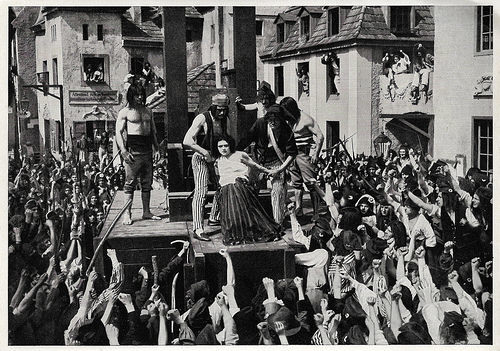
Pola Negri in Madame Dubarry (1919). German collectors card by Ross Verlag in the series Vom Werden deutscher Filmkunst - Der Stumme Film, picture no. 67, group 40. Photo: Ufa. Publicity still for Madame Dubarry (Ernst Lubitsch, 1919). Caption: Pola Negri as Madame Dubarry, execution on the market square in Paris.
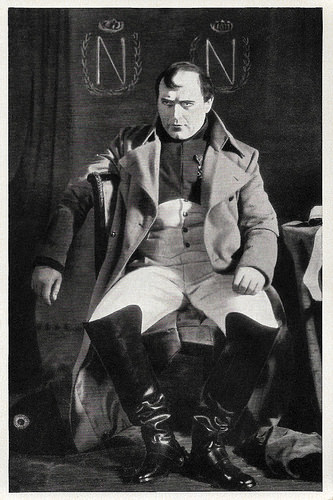
Werner Krauss in Napoleon auf St. Helena (1929). German collectors card by Ross Verlag in the series Vom Werden Deutscher Filmkunst - Der Stumme Film, picture no. 69, group 39. Photo: D.L.S. Publicity still for Napoleon auf St. Helena/Napoleon at St. Helena (Lupu Pick, 1929).
To be continued next Saturday!

Paul Westermeier, Hanne Brinkmann and Hans Albers in Baroneßchen auf Strafurlaub (1917). German collectors card by Ross Verlag in the series Vom Werden deutscher Filmkunst - Der Stumme Film, picture no. 38, group 43. Photo: publicity still for Baroneßchen auf Strafurlaub/Little Baroness on Punishment Holiday (Otto Rippert, 1917). Caption: Paul Westermeier 'works out', Hans Albers - in a small secondary role - is allowed to pinch Hanne Brinkmann in the cheek.

Asta Nielsen , Bruno Kastner and Max Landa in Engelein (1914). German collectors card by Ross Verlag in the series Vom Werden deutscher Filmkunst - Der Stumme Film, picture no. 42, group 40. Photo: Ufa. Publicity still for Engelein/Little Angel (Urban Gad, 1914).

Bruno Kastner , Dorrit Weixler and Frida Richard in Dorittchens Vergnügungsreise (1916). German collectors card by Ross Verlag in the series Vom Werden deutscher Filmkunst - Der Stumme Film, picture no. 45, group 43. Photo: Tobias-Film. Publicity still for Dorittchens Vergnügungsreise/Little Dorrit's Pleasure Trip (Paul Heidemann, 1916).

Ossi Oswalda in Kakadu und Kiebitz (1920). German collectors card by Ross Verlag in the series Vom Werden deutscher Filmkunst - Der Stumme Film, picture no. 46, group 43. Photo: Ufa. Publicity still for Kakadu und Kiebitz/Kakadu and Kiebitz (Erich Schönfelder, 1920).

Carl Auen in Der heulende Wolf (1919). German collectors card by Ross Verlag in the series Vom Werden deutscher Filmkunst - Der Stumme Film, picture no. 50, group 43. Photo: Ufa. Publicity still for Der heulende Wolf/The Crying Wolf (Leo Lasko, 1919). Caption: " Carl Auen as detective in The Crying Wolf".

Erika Glässner . German collectors card by Ross Verlag in the series Vom Werden deutscher Filmkunst - Der Stumme Film, picture no. 52, group 43. Photo: Alex Binder. Caption: " Erika Glässner , the Backfisch (young flapper) from West Berlin in many Aufklärungsfilmen (educational films on social issues)."

Mia May in Veritas Vincit (1919). German collectors card by Ross Verlag in the series Vom Werden deutscher Filmkunst - Der Stumme Film, picture no. 55, group 40. Photo: Ufa. Publicity still for Veritas Vincit (Joe May, 1919).

Emil Jannings and Pola Negri in Die Augen der Mumie Ma (1918). German collectors card by Ross Verlag in the series Vom Werden deutscher Filmkunst - Der Stumme Film, picture no. 58, group 40. Photo: Ufa. Publicity still for Die Augen der Mumie Ma/The Eyes of the Mummy (Ernst Lubitsch, 1918).

Harry Liedtke and Pola Negri in Carmen (1918). German collectors card by Ross Verlag in the series Vom Werden deutscher Filmkunst - Der Stumme Film, picture no, 59, group 43. Photo: Ufa. Publicity still for Carmen (Ernst Lubitsch, 1918).

Mia May in Herrin der Welt (1919-1920). German collectors card by Ross Verlag in the series Vom Werden deutscher Filmkunst - Der Stumme Film, picture no. 62, group 40. Photo: Ufa. Publicity still for Die Herrin der Welt/Mistress of the World (Joe May and others, 1919).

Lil Dagover and Carl de Vogt in Die Spinnen (1919). German photocard for the album Vom Werden deutscher Filmkunst. Teil I. Der stumme Film by Ross Verlag, picture no. 63. Photo: Decla-Film. Publicity still for Die Spinnen/The Spiders (Fritz Lang, 1919-1920).
Georg Alexander , Harry Liedtke and Hubert von Meyerinck in Der Mann ohne Namen (1921). German collectors card by Ross Verlag in the series Vom Werden deutscher Filmkunst - Der Stumme Film, picture no. 64, group 43. Photo: Ufa. Publicity still for Der Mann ohne Nahmen/The Man Without a Name (Georg Jacoby, 1921).

Ellen Richter , Anton Pointner and Hans Brausewetter in Der flug um den Erdball (1925). German collectors card by Ross Verlag in the series Vom Werden deutscher Filmkunst - Der Stumme Film, picture no. 66. Photo: Ellen-Richter-Film. Publicity still for Der flug um den Erdball/The flight around the globe (Willi Wolff, 1925).

Pola Negri in Madame Dubarry (1919). German collectors card by Ross Verlag in the series Vom Werden deutscher Filmkunst - Der Stumme Film, picture no. 67, group 40. Photo: Ufa. Publicity still for Madame Dubarry (Ernst Lubitsch, 1919). Caption: Pola Negri as Madame Dubarry, execution on the market square in Paris.

Werner Krauss in Napoleon auf St. Helena (1929). German collectors card by Ross Verlag in the series Vom Werden Deutscher Filmkunst - Der Stumme Film, picture no. 69, group 39. Photo: D.L.S. Publicity still for Napoleon auf St. Helena/Napoleon at St. Helena (Lupu Pick, 1929).
To be continued next Saturday!
Published on August 11, 2017 22:00
August 10, 2017
Margaret Lee
Cool and beautiful Margaret Lee (1943) posed as a glamorous starlet for many international magazines throughout the 1960s. Between 1962 and 1983 the British born actress co-starred in over 70 European films.
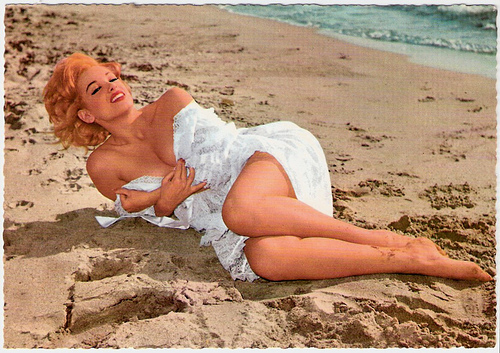
German postcard by Krüger, no. 902/361. Photo: Georg Michalke.
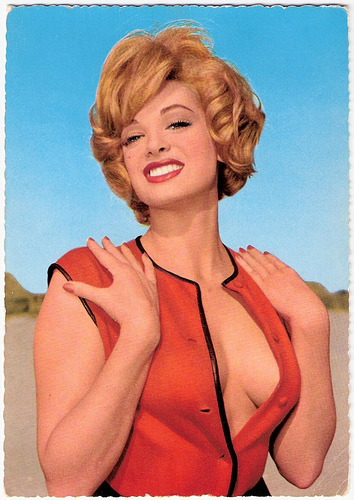
German postcard by Kruger, no. 902/356. Photo: Georg Michalke.
Blonde, Fluffy Look
Margaret (sometimes credited as Margareth) Lee was born Margaret Gwendolyn Box in Wolverhampton, England in 1943. Her mother, who lived in wartime London, was evacuated because of the bombing to a family in Wolverhampton in the West Midlands, whom she had never met before.
After the bombing ended mother and daughter returned to London, and Margaret grew up there. She was educated at Roan Grammar School in Greenwich, and later studied for three years at the Italia Conti Theatre School in London.
Margaret Lee in an interview with the blog Du dumme Sau! : "I wanted to act in the Theatre (never thought of films) and was willing to take any path that might lead me there. I read in The Stage of auditions for showgirls at the famous Moulin Rouge in Paris. I was 17. I wanted to get away from home, and so I auditioned and was taken on.
Then almost a year later, a friend told me they were interviewing for small parts in Cleopatra with Elizabeth Taylor in Rome. I auditioned and was accepted. Within two weeks I was in Rome and going to Cinecitta Film Studios each day. In the end, however, many hours of the film were cut, including my appearances."
At the set of Cleopatra (Joseph L. Mankiewicz, 1963), she met Gino Malerba, who worked as an assistant to choreographer Hermes Pan. When the filming of Cleopatra ended he introduced her to an agent, Fillipo Fortini. They both hoped in this way Lee could get work as an actress in Rome and not have to return to London. It worked and Malerba and Lee would later marry.
She made her screen debut in Maciste contro i mostri/Fire Monsters Against the Son of Hercules (Guido Malatesta, 1962) opposite bodybuilder Reg Lewis.
With a blonde, fluffy look modelled after Marilyn Monroe , Lee followed it up with a stream of low-budget Peplum spectacles, comedies and thrillers. Some of them are now considered cult films.
Highlights include Gli Imbroglioni/The Swindlers (Lucio Fulci, 1963) with Walter Chiari , the comedy In ginocchio da te/On My Knees For You (Ettore Maria Fizzarotti, 1964) starring singer Gianni Morandi , Questa volta parliamo di uomini/Let's Talk About Men (Lina Wertmüller, 1965) with Nino Manfredi , and Casanova '70 (Mario Monicelli, 1965) with Marcello Mastroianni .
She appeared in several comedies and parodies which starred the popular comedic duo Franco Franchi and Ciccio Ingrassia. Few of these films received much (if any) distribution in foreign territories, but they were highly successful in Italy and made Lee a well-known film actress there.
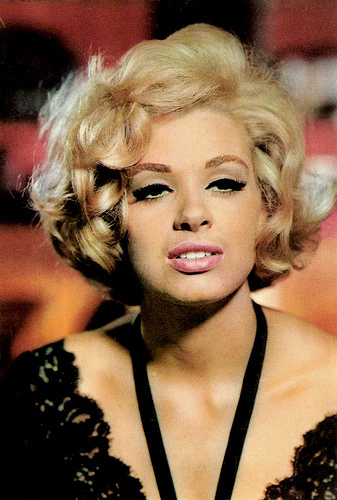
Israelian postcard by Éditions de Luxe, no. 123.
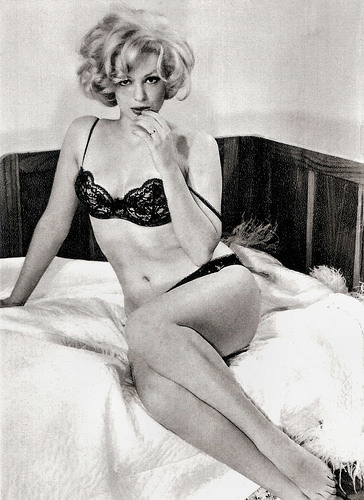
Italian collectors Ccrd by La Rotografica Romana. Edito dalla Nat Nuova Alta Tensione.
Sexy Femme Fatales
Around the mid 1960s, Margaret Lee started to appear in a long line of Eurospy films, where she was frequently cast as the sexy femme fatale. Her appearance also changed as she dropped the blonde look and became a brunette instead.
These Eurospy films include Le Tigre se parfume à la dynamite/An Orchid for the Tiger (Claude Chabrol, 1965), Agente 077 dall'oriente con furore/Agent 077 From the Orient with Fury (Sergio Grieco, 1965), Se tutte le donne del mondo/Kiss the Girls and Make Them Die (Henry Levin, 1966) with American TV star Mike Connors, and the French James Bond variation Coplan sauve sa peau/Coplan Saves His Skin (Yves Boisset, 1968) opposite Claudio Brook and Jean Servais .
Lee was also popular on Italian television in the 1960s. She appeared as a showgirl alongside the famous singer Johnny Dorelli. Lee also starred with Dorelli in his film debut Arriva Dorellik/How to Kill 400 Duponts (Steno, 1967).
She was also seen in sexy parts opposite opposite Jean Gabin and Robert Stack in Le soleil des voyous/Action Man (Jean Delannoy, 1967), and with Gian Maria Volonté in Banditi a Milano/The Violent Four (Carlo Lizzani, 1968).
Lee speaks both English and Italian fluently, and from 1966 on she dubbed most of her own films.
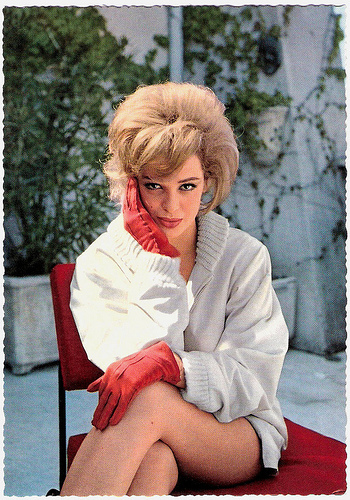
German postcard by Kruger, no. 902/170.
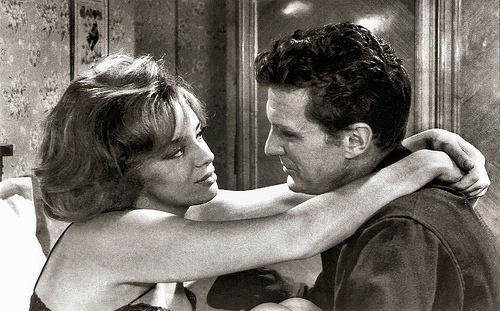
Romanian postcard by Casa Filmului Acin. Publicity still for Le soleil des voyous/Action Man (Jean Delannoy, 1967) with Robert Stack.
Giallo
Margaret Lee caught the eye of international film producer Harry Alan Towers. He gave her wider international recognition by casting her in prominent roles in several of his all-star cast productions.
The first was the British Edgar Wallace mystery Circus of Fear (John Llewellyn Moxey, 1966) starring Christopher Lee .
Towers also cast her in the spy-comedy Our Man in Marrakesh (Don Sharp, 1966), the action film Five Golden Dragons (Jeremy Summers, 1967), the thrillers Paroxismus/Venus in Furs (1969) and Il trono di fuoco/The Bloody Judge (1970), both directed by Jesús Franco.
Finally, Lee also costarred in the Oscar Wilde adaptation Dorian Gray (Massimo Dallamano, 1970) starring Helmut Berger .
Lee's co-star in Circus of Fear, Five Golden Dragons and Venus in Furs was the renowned German actor Klaus Kinski , who was also a regular in Harry Alan Towers productions. The pairing of Lee and Kinski proved to be very popular among cinema-goers - especially in Italy - so they would appear in a total of 12 films together.
Other interesting films in which Margaret Lee appeared were I Bastardi/Sons of Satan (Duccio Tessari, 1969) - one of the last films of Rita Hayworth , and the Giallo (Italian thriller) Gli assassini sono nostri ospiti/The Killers Are Our Guests (Vincenzo Rigo, 1974) starring Anthony Steffen .
However, with the death of the Spy genre in the late 1960s, Margaret Lee was then often cast in popular Euro horror flicks. Wikipedia notes: "By the early 1970s, Lee's movie career had descended further and further into exploitation; culminating in Fernando Di Leo's extremely sleazy and violent thriller La bestia uccide a sangue freddo/Slaughter Hotel (1971)."
In 1974 she retired from the film industry and returned to England. In 1982 she came back for two more films, the comedies Sesso e volentieri/Sex As You Like It (Dino Risi, 1982), which reunited her with her old co-star Johnny Dorelli, and Stangata napoletana/Neapolitan Sting (Vittorio Caprioli, 1983) starring Treat Williams.
Margaret Lee married in 1963 choreographer/agent Gino Malerba. From this marriage which soon ended in a divorce, she had a son, producer/production manager Roberto Malerba of V for Vendetta (James McTeigue, 2006) and Speed Racer (Andy Wachowski, Lana Wachowski, 2008).
After retiring in England she married again and had another son, production coordinator Damian Anderson of V for Vendetta (James McTeigue, 2006) and Ninja Asassin (James McTeigue, 2009).
In 1987, Margaret Lee moved to the Bay Area in California. In 1988 she studied the Stanislavsi 'Method' Acting techniques for a year with Jean Shelton in San Francisco. Later she worked as a stage actress in a small theatre.
Margaret Lee performs an Italo-pop lounge act in the Diabolik parody Arriva Dorellik (1967). Source: Modcinema (YouTube).
Margaret Lee sings the title song in Five Golden Dragons (1967). Source: Filmfan3 (YouTube).
Trailer La bestia Uccide a Sangue Freddo/Slaughter Hotel (1971). Source: Films&Clips (YouTube).
Sources: Du dumme Sau – a Kinski Blog, Brian J. Walker (Brian's Drive-in Theater), Sandra Brennan (Allmovie), Wikipedia and .

German postcard by Krüger, no. 902/361. Photo: Georg Michalke.

German postcard by Kruger, no. 902/356. Photo: Georg Michalke.
Blonde, Fluffy Look
Margaret (sometimes credited as Margareth) Lee was born Margaret Gwendolyn Box in Wolverhampton, England in 1943. Her mother, who lived in wartime London, was evacuated because of the bombing to a family in Wolverhampton in the West Midlands, whom she had never met before.
After the bombing ended mother and daughter returned to London, and Margaret grew up there. She was educated at Roan Grammar School in Greenwich, and later studied for three years at the Italia Conti Theatre School in London.
Margaret Lee in an interview with the blog Du dumme Sau! : "I wanted to act in the Theatre (never thought of films) and was willing to take any path that might lead me there. I read in The Stage of auditions for showgirls at the famous Moulin Rouge in Paris. I was 17. I wanted to get away from home, and so I auditioned and was taken on.
Then almost a year later, a friend told me they were interviewing for small parts in Cleopatra with Elizabeth Taylor in Rome. I auditioned and was accepted. Within two weeks I was in Rome and going to Cinecitta Film Studios each day. In the end, however, many hours of the film were cut, including my appearances."
At the set of Cleopatra (Joseph L. Mankiewicz, 1963), she met Gino Malerba, who worked as an assistant to choreographer Hermes Pan. When the filming of Cleopatra ended he introduced her to an agent, Fillipo Fortini. They both hoped in this way Lee could get work as an actress in Rome and not have to return to London. It worked and Malerba and Lee would later marry.
She made her screen debut in Maciste contro i mostri/Fire Monsters Against the Son of Hercules (Guido Malatesta, 1962) opposite bodybuilder Reg Lewis.
With a blonde, fluffy look modelled after Marilyn Monroe , Lee followed it up with a stream of low-budget Peplum spectacles, comedies and thrillers. Some of them are now considered cult films.
Highlights include Gli Imbroglioni/The Swindlers (Lucio Fulci, 1963) with Walter Chiari , the comedy In ginocchio da te/On My Knees For You (Ettore Maria Fizzarotti, 1964) starring singer Gianni Morandi , Questa volta parliamo di uomini/Let's Talk About Men (Lina Wertmüller, 1965) with Nino Manfredi , and Casanova '70 (Mario Monicelli, 1965) with Marcello Mastroianni .
She appeared in several comedies and parodies which starred the popular comedic duo Franco Franchi and Ciccio Ingrassia. Few of these films received much (if any) distribution in foreign territories, but they were highly successful in Italy and made Lee a well-known film actress there.

Israelian postcard by Éditions de Luxe, no. 123.

Italian collectors Ccrd by La Rotografica Romana. Edito dalla Nat Nuova Alta Tensione.
Sexy Femme Fatales
Around the mid 1960s, Margaret Lee started to appear in a long line of Eurospy films, where she was frequently cast as the sexy femme fatale. Her appearance also changed as she dropped the blonde look and became a brunette instead.
These Eurospy films include Le Tigre se parfume à la dynamite/An Orchid for the Tiger (Claude Chabrol, 1965), Agente 077 dall'oriente con furore/Agent 077 From the Orient with Fury (Sergio Grieco, 1965), Se tutte le donne del mondo/Kiss the Girls and Make Them Die (Henry Levin, 1966) with American TV star Mike Connors, and the French James Bond variation Coplan sauve sa peau/Coplan Saves His Skin (Yves Boisset, 1968) opposite Claudio Brook and Jean Servais .
Lee was also popular on Italian television in the 1960s. She appeared as a showgirl alongside the famous singer Johnny Dorelli. Lee also starred with Dorelli in his film debut Arriva Dorellik/How to Kill 400 Duponts (Steno, 1967).
She was also seen in sexy parts opposite opposite Jean Gabin and Robert Stack in Le soleil des voyous/Action Man (Jean Delannoy, 1967), and with Gian Maria Volonté in Banditi a Milano/The Violent Four (Carlo Lizzani, 1968).
Lee speaks both English and Italian fluently, and from 1966 on she dubbed most of her own films.

German postcard by Kruger, no. 902/170.

Romanian postcard by Casa Filmului Acin. Publicity still for Le soleil des voyous/Action Man (Jean Delannoy, 1967) with Robert Stack.
Giallo
Margaret Lee caught the eye of international film producer Harry Alan Towers. He gave her wider international recognition by casting her in prominent roles in several of his all-star cast productions.
The first was the British Edgar Wallace mystery Circus of Fear (John Llewellyn Moxey, 1966) starring Christopher Lee .
Towers also cast her in the spy-comedy Our Man in Marrakesh (Don Sharp, 1966), the action film Five Golden Dragons (Jeremy Summers, 1967), the thrillers Paroxismus/Venus in Furs (1969) and Il trono di fuoco/The Bloody Judge (1970), both directed by Jesús Franco.
Finally, Lee also costarred in the Oscar Wilde adaptation Dorian Gray (Massimo Dallamano, 1970) starring Helmut Berger .
Lee's co-star in Circus of Fear, Five Golden Dragons and Venus in Furs was the renowned German actor Klaus Kinski , who was also a regular in Harry Alan Towers productions. The pairing of Lee and Kinski proved to be very popular among cinema-goers - especially in Italy - so they would appear in a total of 12 films together.
Other interesting films in which Margaret Lee appeared were I Bastardi/Sons of Satan (Duccio Tessari, 1969) - one of the last films of Rita Hayworth , and the Giallo (Italian thriller) Gli assassini sono nostri ospiti/The Killers Are Our Guests (Vincenzo Rigo, 1974) starring Anthony Steffen .
However, with the death of the Spy genre in the late 1960s, Margaret Lee was then often cast in popular Euro horror flicks. Wikipedia notes: "By the early 1970s, Lee's movie career had descended further and further into exploitation; culminating in Fernando Di Leo's extremely sleazy and violent thriller La bestia uccide a sangue freddo/Slaughter Hotel (1971)."
In 1974 she retired from the film industry and returned to England. In 1982 she came back for two more films, the comedies Sesso e volentieri/Sex As You Like It (Dino Risi, 1982), which reunited her with her old co-star Johnny Dorelli, and Stangata napoletana/Neapolitan Sting (Vittorio Caprioli, 1983) starring Treat Williams.
Margaret Lee married in 1963 choreographer/agent Gino Malerba. From this marriage which soon ended in a divorce, she had a son, producer/production manager Roberto Malerba of V for Vendetta (James McTeigue, 2006) and Speed Racer (Andy Wachowski, Lana Wachowski, 2008).
After retiring in England she married again and had another son, production coordinator Damian Anderson of V for Vendetta (James McTeigue, 2006) and Ninja Asassin (James McTeigue, 2009).
In 1987, Margaret Lee moved to the Bay Area in California. In 1988 she studied the Stanislavsi 'Method' Acting techniques for a year with Jean Shelton in San Francisco. Later she worked as a stage actress in a small theatre.
Margaret Lee performs an Italo-pop lounge act in the Diabolik parody Arriva Dorellik (1967). Source: Modcinema (YouTube).
Margaret Lee sings the title song in Five Golden Dragons (1967). Source: Filmfan3 (YouTube).
Trailer La bestia Uccide a Sangue Freddo/Slaughter Hotel (1971). Source: Films&Clips (YouTube).
Sources: Du dumme Sau – a Kinski Blog, Brian J. Walker (Brian's Drive-in Theater), Sandra Brennan (Allmovie), Wikipedia and .
Published on August 10, 2017 22:00
August 9, 2017
Die Sieger (1918)
We continue our irregular series of film specials. Today, we chose for a silent melodrama of one of the three great German divas of the silent cinema, Henny Porten. The sturdy and blond actress is the star of Die Sieger/The Victors (Rudolf Biebrach, 1918) produced by the Messter Film studio. Rotophot made a beautiful series of postcards with sepia photos for the film.
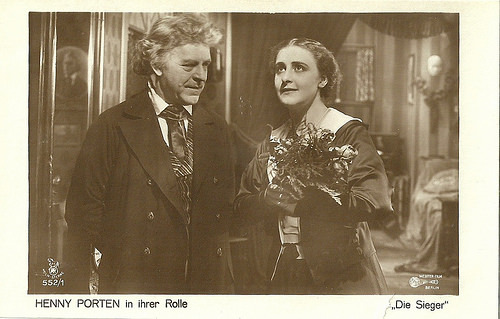
German postcard by Rotophot in the Film-Sterne series, no. 552/1. Photo: Messter Film. Publicity still of Henny Porten and Rudolf Biebrach in Die Sieger (Rudolf Biebrach, 1918).
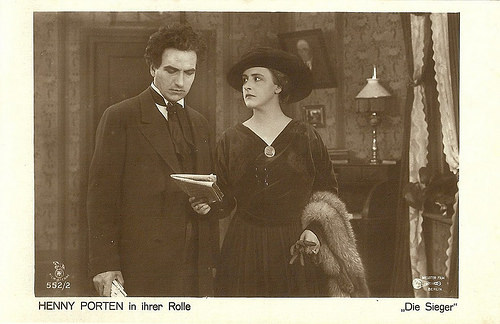
German postcard by Rotophot in the Film-Sterne series, no. 552/2. Photo: Messter Film. Publicity still of Henny Porten and Bruno Decarli in Die Sieger (Rudolf Biebrach, 1918).
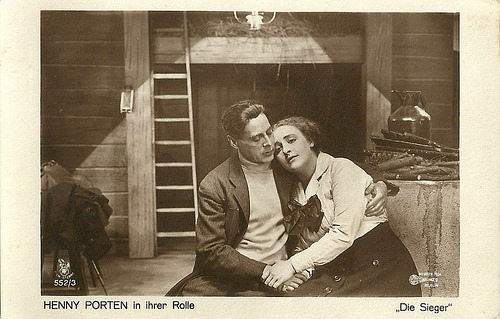
German postcard by Rotophot in the Film-Sterne series, no. 552/3. Photo: Messter Film. Publicity still of Henny Porten and Arthur Bergen in Die Sieger (Rudolf Biebrach, 1918).
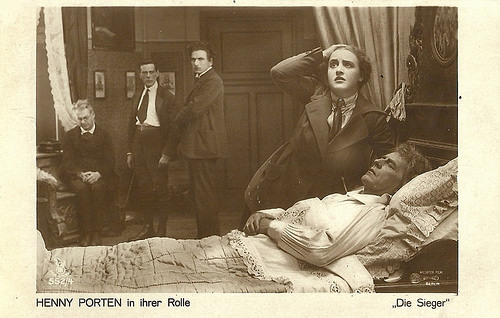
German postcard by Rotophot in the Film-Sterne series, no. 552/4. Photo: Messter Film. Publicity still of Henny Porten and Rudolf Biebrach, and in the background Paul Biensfeldt, Bruno Decarli and Arthur Bergen in Die Sieger (Rudolf Biebrach, 1918).
Opera Fraud
Die Sieger/The Victors (Rudolf Biebrach, 1918) was based on a novel by Felix Philippi, who also wrote the script. Cinematographer was Karl Freund and the set designer was Jack Winter.
Director Rudolf Biebrach himself played the part of musical professor Richard Assing, who has completed his masterpiece, the opera Die Sieger (The Victors). Sadly, before he can perform it, he has a heart attack.
On his deathbed he urges his favourite pupil Camille Düpaty (Arthur Bergen) to have the opera performed. Camille loves Assing's daughter Konstanze ( Henny Porten ), who has promised to marry him if he can compose a substantial work, equal to her father's work. Camille then plots to release Assing's opera under another title as his work.
The opera becomes a giant success. However, Sigmund Freystetter ( Bruno Decarli ), music critic and an old friend of Konstanze, discovers the fraud. Konstanze now knows who she really loves and leaves Camille for Sigmund.
Die Sieger/The Victors premiered at the Berlin Mozartsaal cinema on 27 September 1918. For the premiere, Giuseppe Becce had composed a musical score.
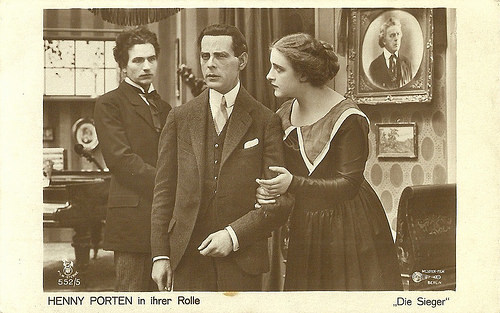
German postcard by Rotophot in the Film-Sterne series, no. 552/5. Photo: Messter Film. Publicity still of Henny Porten , Arthur Bergen and in the background Bruno Decarli in Die Sieger (Rudolf Biebrach, 1918).
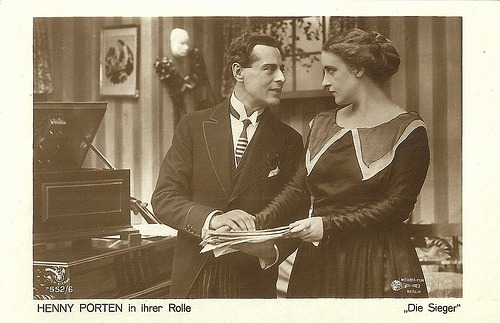
German postcard by Rotophot in the Film-Sterne series, no. 552/6. Photo: Messter Film. Publicity still of Henny Porten and Arthur Bergen in Die Sieger (Rudolf Biebrach, 1918).
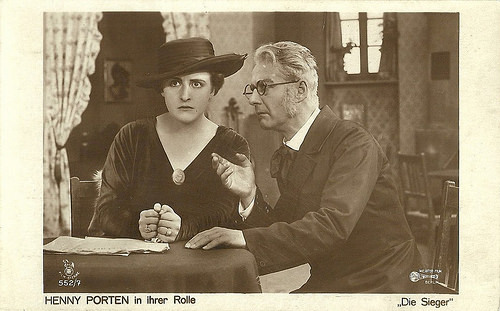
German postcard by Rotophot in the Film-Sterne series, no. 552/7. Photo: Messter Film. Publicity still of Henny Porten and Paul Biensfeldt in Die Sieger (Rudolf Biebrach, 1918).
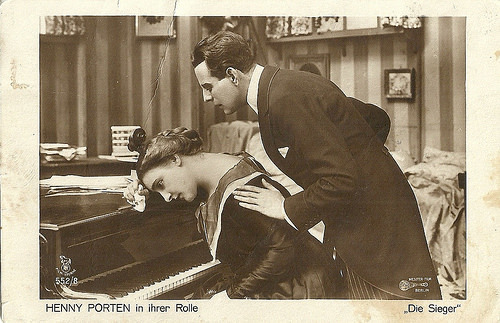
German postcard by Rotophot in the Film-Sterne series, no. 552/8. Photo: Messter Film. Publicity still of Henny Porten and Arthur Bergen in Die Sieger (Rudolf Biebrach, 1918).
Source: Filmportal.de (German), Wikipedia (German) and IMDb.

German postcard by Rotophot in the Film-Sterne series, no. 552/1. Photo: Messter Film. Publicity still of Henny Porten and Rudolf Biebrach in Die Sieger (Rudolf Biebrach, 1918).

German postcard by Rotophot in the Film-Sterne series, no. 552/2. Photo: Messter Film. Publicity still of Henny Porten and Bruno Decarli in Die Sieger (Rudolf Biebrach, 1918).

German postcard by Rotophot in the Film-Sterne series, no. 552/3. Photo: Messter Film. Publicity still of Henny Porten and Arthur Bergen in Die Sieger (Rudolf Biebrach, 1918).

German postcard by Rotophot in the Film-Sterne series, no. 552/4. Photo: Messter Film. Publicity still of Henny Porten and Rudolf Biebrach, and in the background Paul Biensfeldt, Bruno Decarli and Arthur Bergen in Die Sieger (Rudolf Biebrach, 1918).
Opera Fraud
Die Sieger/The Victors (Rudolf Biebrach, 1918) was based on a novel by Felix Philippi, who also wrote the script. Cinematographer was Karl Freund and the set designer was Jack Winter.
Director Rudolf Biebrach himself played the part of musical professor Richard Assing, who has completed his masterpiece, the opera Die Sieger (The Victors). Sadly, before he can perform it, he has a heart attack.
On his deathbed he urges his favourite pupil Camille Düpaty (Arthur Bergen) to have the opera performed. Camille loves Assing's daughter Konstanze ( Henny Porten ), who has promised to marry him if he can compose a substantial work, equal to her father's work. Camille then plots to release Assing's opera under another title as his work.
The opera becomes a giant success. However, Sigmund Freystetter ( Bruno Decarli ), music critic and an old friend of Konstanze, discovers the fraud. Konstanze now knows who she really loves and leaves Camille for Sigmund.
Die Sieger/The Victors premiered at the Berlin Mozartsaal cinema on 27 September 1918. For the premiere, Giuseppe Becce had composed a musical score.

German postcard by Rotophot in the Film-Sterne series, no. 552/5. Photo: Messter Film. Publicity still of Henny Porten , Arthur Bergen and in the background Bruno Decarli in Die Sieger (Rudolf Biebrach, 1918).

German postcard by Rotophot in the Film-Sterne series, no. 552/6. Photo: Messter Film. Publicity still of Henny Porten and Arthur Bergen in Die Sieger (Rudolf Biebrach, 1918).

German postcard by Rotophot in the Film-Sterne series, no. 552/7. Photo: Messter Film. Publicity still of Henny Porten and Paul Biensfeldt in Die Sieger (Rudolf Biebrach, 1918).

German postcard by Rotophot in the Film-Sterne series, no. 552/8. Photo: Messter Film. Publicity still of Henny Porten and Arthur Bergen in Die Sieger (Rudolf Biebrach, 1918).
Source: Filmportal.de (German), Wikipedia (German) and IMDb.
Published on August 09, 2017 22:00
August 8, 2017
Linda Moglia
Linda Moglia (1896-?) was an Italian actress of the silent screen, who peaked in the late 1910s and early 1920s. Her biggest role was that of Roxane in Cirano di Bergerac (Augusto Genina, 1923).

Italian postcard by Ed. A. Traldi, Milano, no. 558.

Italian postcard by Fotocelere, Torino, no. 80.
Mouthpiece of anti-labour sentiment
Linda Moglia was born in 1896 in Turin, Italy.
She probably made her film acting debut in Il doppio volto/The Two-Face (Giulio Antamoro, 1918). This Poli-Film production was by adapted from a rather unknown novel by Matilde Serao. It was a modest Neapolitan production with scarce success but it procured Moglia an entree to the Turin Ambrosio studios.
At Ambrosio, she appeared in Noblesse oblige (1919), based on a French ‘pochade’ by the duo Maurice Hennequin and Pierre Veber, and directed by the famous poster designer Marcello Dudovich. Ambrosio never mentioned his name at the time. Linda starred in the film with her sister Lucia, whose screen name was Lucy Di San Germano or Lucy Sangermano.
After this film, she was the female counterpart to the popular comedian Luciano Manara in the Ambrosio production Il processo Manara (Paolo Trinchera, 1919), which was well received, in contrast to the Gladiator Film production Centocelle (1919), in which Moglia had a supporting part opposite diva Helena Makowska . In particular the direction by Ugo de Simone was considered the culprit for the tedious and monotonous film.
She then appeared in Maciste innamorato/Maciste in Love (Luigi Romano Borgnetto 1919), one of the rare Maciste films in which Maciste has a love affair. Moglia plays Ada, the daughter of an industrialist, who is menaced by revolts and strikes at a time that, also outside of the cinema, Italian society was a place of turmoil. Strongman Maciste ( Bartolomeo Pagano ) helps to fight the strikers, in particular the few ‘rotten apples’ among them.
Jacqueline Reich writes in her book The Maciste Films of Italian Silent Cinema: “Yet, all is not rosy among the workers and the ruling class, as personified in the figure of Ada, who is the mouthpiece of anti-labour sentiment. It is she who voices the fear of the strike –“Lord, no, a strike” – and who calls the workers “scoundrels” as they begin to attack on her father, employing the same word in a generalized fashion that her father subsequently uses to characterize only a few nefarious individuals. […] Her antipathy and resistance to the working and service classes present her as an aloof reactionary.”
The journal Cine-fono commented that the film didn’t give Moglia the right place to show her talents as Maciste dominated everything. So yes, there was a lot to laugh, but how artistic was it? The Museo Nazionale del Cinema in Turin recently restored the film and despite its rather dubious political message, it is quite a well-made and enjoyable film.
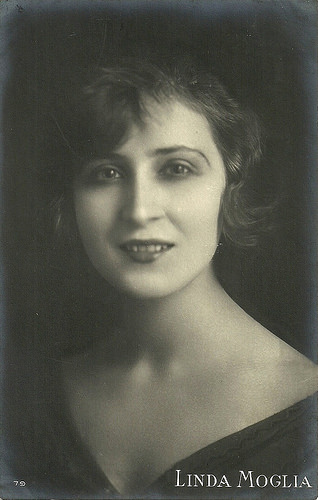
Italian postcard by Fotocelere, Torino.
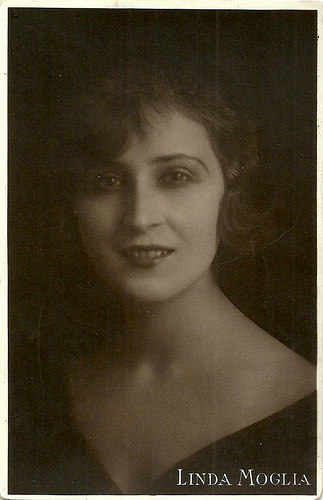
Italian postcard by Fotocelere, Italia.
Doppelganger
Linda Moglia returned to Naples to Poli-Film for Mala Pasqua/Bad Easter (1920). It was directed by actor and director Ignazio Lupi . It was based on Giovanni Grasso’s play Dodici anni dopo (Twelve Years After), a kind of sequel to the famous Cavalleria rusticana by Giovanni Verga, turned into an opera by Pietro Mascagni.
Here Santuzza (Moglia) goes berserk when her son, named Turiddu after his killed father, is lost. Alfio (Grasso), released from prison after having killed Turiddu, shows his best side, and helps finding the child. Even Alfio’s mother, who had gone mad after the killing, returns to reason. The press called this all too good to be true but lauded Grasso’s acting as Alfio plus the care for the setting with the traditional costumes.
Back at Ambrosio, Moglia played the lead in Uomini gialli/Yellow Men (Eugenio Testa, 1920), a ‘Giallo’ on an American girl who suddenly inherits a fortune from a relative who died in Japan. Two Asians try to get the money and force the heiress to marry one of them instead of her fiancee, the painter Borelli (Angelo Vianello). A mysterious man with a black hood (Thenno) helps and unmasks himself as the Japanese consul. Clearly, Ambrosio profited from the European tour of the Japanese Thenno and his troupe of jugglers, acrobats and magicians to enlist them for a film. There is a nitrate of the film at EYE Filmmuseum in Amsterdam, which might have been preserved in the meantime.
In Cavacchioni paladino dei dollari (Umberto Paradisi, 1920), Cavacchioni (lit. Big Buttons, played by Ruggero Capodaglio), the famous fat detective in the Maciste films, lives a quite village life with his house keeper Clitemnestra (Léonie Laporte), when a rich American heiress (Moglia) upsets village life. When evildoers, pushed by the housekeeper, want to rob the girl, the detective sets things straight and peace returns in the village.
A totally different film was Il rivale/The Rival (Enrico Roma 1920), based on a script by Gaetano Campanile-Mancini. The film tells about the scoundrel Leonardo ( Tullio Carminati ), who betrayed his wife which caused a drama. Desperately, she killed herself. From then on, Leonardo is split in two, while his alter ego is always present and reminds him of his guilt. The story ends mysteriously: the real man flees but his alter ego remains to keep the memory of the dead woman alive, like a votive lamp.
The Italian press quite liked this supernatural story, as opposed to the run-of-the-mill dramas and crime films. The splitting of the personality reminds a bit of Der Student von Prag/The Student of Prague (Stellan Rye, Paul Wegener, 1913), but in general in the 1910s and early 1920s, the Doppelganger motif was dear to both mainstream and avant-garde filmmakers.
In Il rivale, Moglia played the man’s mistress, who is married, just like Leonardo. Perhaps motivated by the film, Carminati founded his own film company in Rome, Carminati film, for which Moglia and he were reunited in Follie/Madness (Enrico Roma, 1920). It is the story of a girl who goes to the city and is overwhelmed by its attractions but in the end returns to her lover in the village.
The press was not impressed about the story, but the critic of La Cine-Fono praised the performances by Carminati and Moglia. The truth in their expression and their precise understanding of the psychology of the characters had high artistic qualities and expressed scenes of great human depth, he wrote.

Italian postcard by G.B. Falci, Milano, no. 226. Photo: UCI. Publicity still for the Franco-Italian historical film Cirano di Bergerac (Augusto Genina, 1923).

Italian postcard for the Franco-Italian historical film Cirano di Bergerac/Cyrano de Bergerac (Augusto Genina, 1923), with Pierre Magnier as Cyrano de Bergerac, Linda Moglia as Roxane and Angelo Ferrari as Christian de Neuvillette.

Italian postcard for the Franco-Italian historical film Cirano di Bergerac/Cyrano de Bergerac (Augusto Genina, 1923). Caption: Christian joins the baluster, finally embracing Roxane. He bends towards her mouth to receive the kiss from her, who has bent because of the sweet words Cyrano lent him.
Roxanne
Early 1922, Linda Moglia was taken up by the prestigious historical production Cirano di Bergerac (Augusto Genina, 1923). Based on the famous play by Edmond Rostand and scripted by future director Mario Camerini, Genina led a Franco-Italian coproduction with costumes by Caramba and sets by the famous painter Camillo Innocenti. The production had an enormous length and was distributed in a fully stencil coloured version.
Star of the film was Pierre Magnier as Cyrano, the man with the giant nose while Moglia was his Roxane, his cousin he is deeply in love with, but cannot get because she loves Christian de Neuvillette ( Angelo Ferrari ). Cirano even helps Christian to write love letters and talk about love. It is only years after, after Christian has died and Cyrano is about to die, that Roxanne discovers the secret, but it's too late.
When presented at the National Film Contest in Turin in 1923, it immediately won the first prize. In 1923 it was first commercially released in Paris, at the Salle Marivaux, where it had an enormous success. Italian distributors, though, retaliated, as they thought the film was too difficult for the audience. Finally UCI released it in Turin at the end of 1925, and in Rome even early 1926. The Italian press blamed the distributors for the unnecessary long delay. It had been unnecessary, as people flocked to the cinemas in the first weeks. The critics praised the high artistic qualities of the film, first of all Magnier’s performance.
Strangely enough, Cirano did not result in a breakthrough for Linda Moglia. There followed no foreign offers from France nor elsewhere. Moglia made one last film with Genina as director and with theatre star Ruggero Ruggeri in the lead: the financial drama La moglie bella (Augusto Genina, 1925 in Italy, so even before Cirano ). The story dealt with a wildly speculating banker (Ruggeri), whose spoilt wife (Moglia) has an affair with another banker ( Luigi Serventi ), until the other financially ruins her husband. Then she realises her husband is the better man.
The press condemned Ruggeri’ acting as 'un-filmic' and Genina’s (art) direction as 'sloppy'. This happened at a time when the Italian film production was falling apart and most film people were leaving for Berlin or Paris, so Moglia may have considered it as a good moment to quit.
Supporting actress in La moglie bella was Carmen Boni , whose first film with director Augusto Genina this was. Boni would become Genina’s new muse and wife during the later 1920s. This might also have played a part in Linda Moglia's decision to retire.
After her retirement from the cinema, Linda Moglia disappeared and her date of death is unknown to us. If you have more info, please let us know.

Italian postcard for the Franco-Italian historical film Cirano di Bergerac/Cyrano de Bergerac (Augusto Genina, 1923), with Linda Moglia as Roxane and Angelo Ferrari as Christian de Neuvillette. Caption: the nice phrases of Christian he learned from Cyrano have conquered and seduced Roxane.
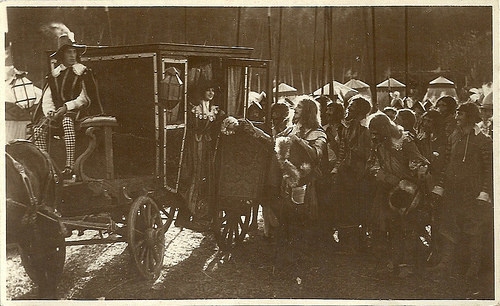
Italian postcard for the Franco-Italian historical film Cirano di Bergerac/Cyrano de Bergerac (Augusto Genina, 1923), with Linda Moglia as Roxane and Angelo Ferrari as Christian de Neuvillette. Caption: Defying danger, Roxane joins Christian at Arras, where he is camping with the soldiers.
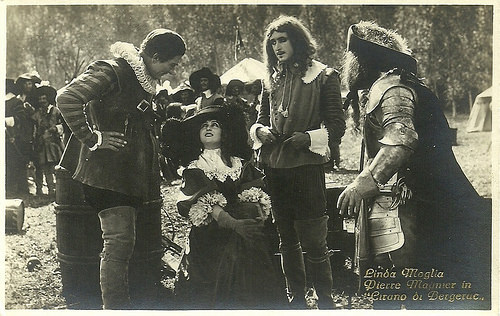
Italian postcard for the Franco-Italian historical film Cirano di Bergerac/Cyrano de Bergerac (Augusto Genina, 1923), with Linda Moglia as Roxane and Angelo Ferrari as Christian de Neuvillette.
Sources: Vittorio Martinelli (Il cinema muto italiano 1918-1924 - Italian), and . For the gorgeous colours of Cirano di Bergerac/Cyrano de Bergerac (Augusto Genina, 1923), see: Timeline of Historical Film Colors and I thank you.

Italian postcard by Ed. A. Traldi, Milano, no. 558.

Italian postcard by Fotocelere, Torino, no. 80.
Mouthpiece of anti-labour sentiment
Linda Moglia was born in 1896 in Turin, Italy.
She probably made her film acting debut in Il doppio volto/The Two-Face (Giulio Antamoro, 1918). This Poli-Film production was by adapted from a rather unknown novel by Matilde Serao. It was a modest Neapolitan production with scarce success but it procured Moglia an entree to the Turin Ambrosio studios.
At Ambrosio, she appeared in Noblesse oblige (1919), based on a French ‘pochade’ by the duo Maurice Hennequin and Pierre Veber, and directed by the famous poster designer Marcello Dudovich. Ambrosio never mentioned his name at the time. Linda starred in the film with her sister Lucia, whose screen name was Lucy Di San Germano or Lucy Sangermano.
After this film, she was the female counterpart to the popular comedian Luciano Manara in the Ambrosio production Il processo Manara (Paolo Trinchera, 1919), which was well received, in contrast to the Gladiator Film production Centocelle (1919), in which Moglia had a supporting part opposite diva Helena Makowska . In particular the direction by Ugo de Simone was considered the culprit for the tedious and monotonous film.
She then appeared in Maciste innamorato/Maciste in Love (Luigi Romano Borgnetto 1919), one of the rare Maciste films in which Maciste has a love affair. Moglia plays Ada, the daughter of an industrialist, who is menaced by revolts and strikes at a time that, also outside of the cinema, Italian society was a place of turmoil. Strongman Maciste ( Bartolomeo Pagano ) helps to fight the strikers, in particular the few ‘rotten apples’ among them.
Jacqueline Reich writes in her book The Maciste Films of Italian Silent Cinema: “Yet, all is not rosy among the workers and the ruling class, as personified in the figure of Ada, who is the mouthpiece of anti-labour sentiment. It is she who voices the fear of the strike –“Lord, no, a strike” – and who calls the workers “scoundrels” as they begin to attack on her father, employing the same word in a generalized fashion that her father subsequently uses to characterize only a few nefarious individuals. […] Her antipathy and resistance to the working and service classes present her as an aloof reactionary.”
The journal Cine-fono commented that the film didn’t give Moglia the right place to show her talents as Maciste dominated everything. So yes, there was a lot to laugh, but how artistic was it? The Museo Nazionale del Cinema in Turin recently restored the film and despite its rather dubious political message, it is quite a well-made and enjoyable film.

Italian postcard by Fotocelere, Torino.

Italian postcard by Fotocelere, Italia.
Doppelganger
Linda Moglia returned to Naples to Poli-Film for Mala Pasqua/Bad Easter (1920). It was directed by actor and director Ignazio Lupi . It was based on Giovanni Grasso’s play Dodici anni dopo (Twelve Years After), a kind of sequel to the famous Cavalleria rusticana by Giovanni Verga, turned into an opera by Pietro Mascagni.
Here Santuzza (Moglia) goes berserk when her son, named Turiddu after his killed father, is lost. Alfio (Grasso), released from prison after having killed Turiddu, shows his best side, and helps finding the child. Even Alfio’s mother, who had gone mad after the killing, returns to reason. The press called this all too good to be true but lauded Grasso’s acting as Alfio plus the care for the setting with the traditional costumes.
Back at Ambrosio, Moglia played the lead in Uomini gialli/Yellow Men (Eugenio Testa, 1920), a ‘Giallo’ on an American girl who suddenly inherits a fortune from a relative who died in Japan. Two Asians try to get the money and force the heiress to marry one of them instead of her fiancee, the painter Borelli (Angelo Vianello). A mysterious man with a black hood (Thenno) helps and unmasks himself as the Japanese consul. Clearly, Ambrosio profited from the European tour of the Japanese Thenno and his troupe of jugglers, acrobats and magicians to enlist them for a film. There is a nitrate of the film at EYE Filmmuseum in Amsterdam, which might have been preserved in the meantime.
In Cavacchioni paladino dei dollari (Umberto Paradisi, 1920), Cavacchioni (lit. Big Buttons, played by Ruggero Capodaglio), the famous fat detective in the Maciste films, lives a quite village life with his house keeper Clitemnestra (Léonie Laporte), when a rich American heiress (Moglia) upsets village life. When evildoers, pushed by the housekeeper, want to rob the girl, the detective sets things straight and peace returns in the village.
A totally different film was Il rivale/The Rival (Enrico Roma 1920), based on a script by Gaetano Campanile-Mancini. The film tells about the scoundrel Leonardo ( Tullio Carminati ), who betrayed his wife which caused a drama. Desperately, she killed herself. From then on, Leonardo is split in two, while his alter ego is always present and reminds him of his guilt. The story ends mysteriously: the real man flees but his alter ego remains to keep the memory of the dead woman alive, like a votive lamp.
The Italian press quite liked this supernatural story, as opposed to the run-of-the-mill dramas and crime films. The splitting of the personality reminds a bit of Der Student von Prag/The Student of Prague (Stellan Rye, Paul Wegener, 1913), but in general in the 1910s and early 1920s, the Doppelganger motif was dear to both mainstream and avant-garde filmmakers.
In Il rivale, Moglia played the man’s mistress, who is married, just like Leonardo. Perhaps motivated by the film, Carminati founded his own film company in Rome, Carminati film, for which Moglia and he were reunited in Follie/Madness (Enrico Roma, 1920). It is the story of a girl who goes to the city and is overwhelmed by its attractions but in the end returns to her lover in the village.
The press was not impressed about the story, but the critic of La Cine-Fono praised the performances by Carminati and Moglia. The truth in their expression and their precise understanding of the psychology of the characters had high artistic qualities and expressed scenes of great human depth, he wrote.

Italian postcard by G.B. Falci, Milano, no. 226. Photo: UCI. Publicity still for the Franco-Italian historical film Cirano di Bergerac (Augusto Genina, 1923).

Italian postcard for the Franco-Italian historical film Cirano di Bergerac/Cyrano de Bergerac (Augusto Genina, 1923), with Pierre Magnier as Cyrano de Bergerac, Linda Moglia as Roxane and Angelo Ferrari as Christian de Neuvillette.

Italian postcard for the Franco-Italian historical film Cirano di Bergerac/Cyrano de Bergerac (Augusto Genina, 1923). Caption: Christian joins the baluster, finally embracing Roxane. He bends towards her mouth to receive the kiss from her, who has bent because of the sweet words Cyrano lent him.
Roxanne
Early 1922, Linda Moglia was taken up by the prestigious historical production Cirano di Bergerac (Augusto Genina, 1923). Based on the famous play by Edmond Rostand and scripted by future director Mario Camerini, Genina led a Franco-Italian coproduction with costumes by Caramba and sets by the famous painter Camillo Innocenti. The production had an enormous length and was distributed in a fully stencil coloured version.
Star of the film was Pierre Magnier as Cyrano, the man with the giant nose while Moglia was his Roxane, his cousin he is deeply in love with, but cannot get because she loves Christian de Neuvillette ( Angelo Ferrari ). Cirano even helps Christian to write love letters and talk about love. It is only years after, after Christian has died and Cyrano is about to die, that Roxanne discovers the secret, but it's too late.
When presented at the National Film Contest in Turin in 1923, it immediately won the first prize. In 1923 it was first commercially released in Paris, at the Salle Marivaux, where it had an enormous success. Italian distributors, though, retaliated, as they thought the film was too difficult for the audience. Finally UCI released it in Turin at the end of 1925, and in Rome even early 1926. The Italian press blamed the distributors for the unnecessary long delay. It had been unnecessary, as people flocked to the cinemas in the first weeks. The critics praised the high artistic qualities of the film, first of all Magnier’s performance.
Strangely enough, Cirano did not result in a breakthrough for Linda Moglia. There followed no foreign offers from France nor elsewhere. Moglia made one last film with Genina as director and with theatre star Ruggero Ruggeri in the lead: the financial drama La moglie bella (Augusto Genina, 1925 in Italy, so even before Cirano ). The story dealt with a wildly speculating banker (Ruggeri), whose spoilt wife (Moglia) has an affair with another banker ( Luigi Serventi ), until the other financially ruins her husband. Then she realises her husband is the better man.
The press condemned Ruggeri’ acting as 'un-filmic' and Genina’s (art) direction as 'sloppy'. This happened at a time when the Italian film production was falling apart and most film people were leaving for Berlin or Paris, so Moglia may have considered it as a good moment to quit.
Supporting actress in La moglie bella was Carmen Boni , whose first film with director Augusto Genina this was. Boni would become Genina’s new muse and wife during the later 1920s. This might also have played a part in Linda Moglia's decision to retire.
After her retirement from the cinema, Linda Moglia disappeared and her date of death is unknown to us. If you have more info, please let us know.

Italian postcard for the Franco-Italian historical film Cirano di Bergerac/Cyrano de Bergerac (Augusto Genina, 1923), with Linda Moglia as Roxane and Angelo Ferrari as Christian de Neuvillette. Caption: the nice phrases of Christian he learned from Cyrano have conquered and seduced Roxane.

Italian postcard for the Franco-Italian historical film Cirano di Bergerac/Cyrano de Bergerac (Augusto Genina, 1923), with Linda Moglia as Roxane and Angelo Ferrari as Christian de Neuvillette. Caption: Defying danger, Roxane joins Christian at Arras, where he is camping with the soldiers.

Italian postcard for the Franco-Italian historical film Cirano di Bergerac/Cyrano de Bergerac (Augusto Genina, 1923), with Linda Moglia as Roxane and Angelo Ferrari as Christian de Neuvillette.
Sources: Vittorio Martinelli (Il cinema muto italiano 1918-1924 - Italian), and . For the gorgeous colours of Cirano di Bergerac/Cyrano de Bergerac (Augusto Genina, 1923), see: Timeline of Historical Film Colors and I thank you.
Published on August 08, 2017 22:00
August 7, 2017
Diana Wynyard
Elegant and aristocratic British actress Diana Wynyard (1906-1964) was a leading lady on the London stage. She was the first British actress to be nominated for the Academy Award for Best Actress, but her Hollywood career was brief and largely unsatisfactory. She returned to the screen successfully in England in the first film version of Gas Light (1940), and although she didn't make many films, she had a secure place in the roll call of great British film stars.
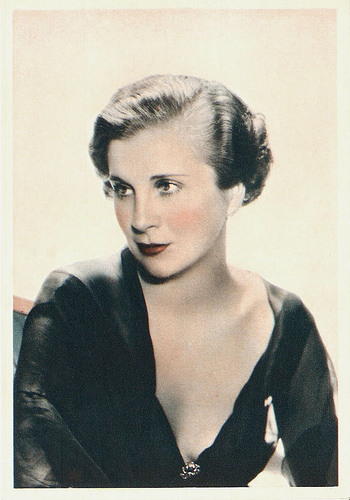
British postcard by De Reszke Cigarettes, no. 3.

British postcard in the Picturegoer series, London, no. 729a. Sent by mail in 1934. Photo: MGM.
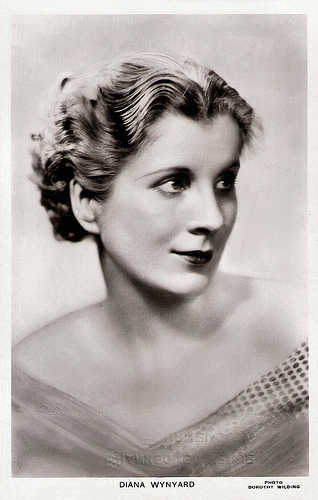
British postcard in the Picturegoer series, London, no. 906. Photo: Dorothy Wilding.
Three Barrymores
Diana Wynyard was born Dorothy Isobel Cox in London in 1906. The acting bug struck early, and by the mid-twenties she was doing walk-ons in the West End. After a spell in Liverpool rep she returned to the capital, becoming a star in Sorry You've Been Troubled.
In 1932 she appeared in New York opposite Basil Rathbone in The Devil Passes. Hollywood noticed and she appeared first as Princess Natasha in the MGM production Rasputin and the Empress (Richard Boleslawski, 1932). Wynyard managed to make an excellent impression despite the overshadowing presence of three Barrymores - John, Lionel, and Ethel - in the cast.
It was the (off screen) rape of Wynyard's character by Rasputin (Lionel Barrymore) that led an expatriate Russian princess to sue MGM, claiming that Natasha was based on the princess. This is why all subsequent American films carried the "any resemblance to any persons living or dead" disclaimer.
Fox then borrowed her for their lavish film version of Noel Coward's stage spectacle Cavalcade (Frank Lloyd, 1933). As the noble wife and mother she aged gracefully against a background of the Boer War, the sinking of the Titanic, the First World War, and the arrival of the Jazz Age. With this performance, she became the first British actress to be nominated for the Academy Award for Best Actress.
However, in an era dominated by gangster films and musicals she proved difficult to cast. Other Hollywood appearances were as John Barrymore's old flame in Reunion in Vienna (Sidney Franklin, 1933) and most notably in James Whale’s masterpiece One More River (1934) as an abused high society wife trying to wrench free of her extremely nasty husband.
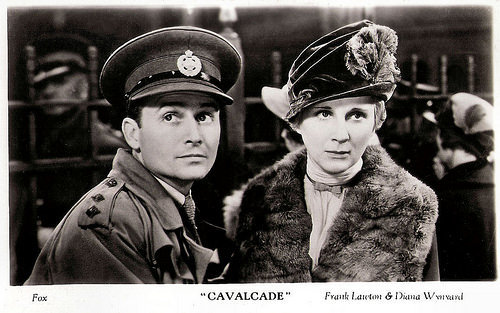
British postcard in the Filmshots series by Film Weekly. Photo: Fox. Publicity still for Cavalcade (Frank Lloyd, 1933) with Diana Wynyard and Frank Lawton.
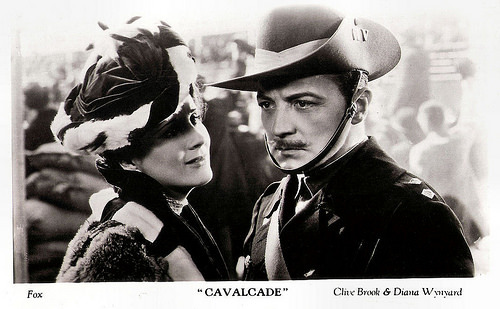
British postcard in the Filmshots series by Film Weekly. Photo: Fox. Publicity still for Cavalcade (Frank Lloyd, 1933) with Clive Brook.
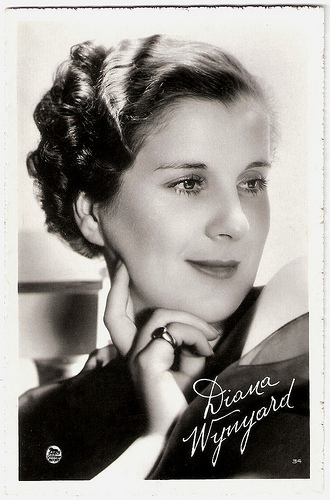
French postcard, no. 34. Photo: 20th Century Fox.

British postcard, no. 91. Photo: MGM.
Tormented Heiress
After this brief and largely unsatisfactory Hollywood career, Diana Wynyard returned to Britain. Here she concentrated on theatre work, including roles as Charlotte Brontë in Clemence Dane's Wild Decembers, in Sweet Aloes, and as Gilda in the British premiere of Noel Coward's Design for Living.
She was tempted to return to the screen to play opposite Ralph Richardson in On the Night of the Fire (Brian Desmond Hurst, 1939). Then she had a great success as the frightened heroine of the first film version of Patrick Hamilton's play Gas Light (Thorold Dickinson, 1940). This is her most revived performance.
Gaslight was thought lost for years, because MGM destroyed it when they remade it with Ingrid Bergman . Fortunately, a few prints were illegally smuggled out of England and the film is still in existence. As the heiress tormented by husband Anton Walbrook Diana Wynyard is unforgettable.
Thanks to the blitz, legitimate theatre work was unpredictable so she continued to film, including roles opposite Clive Brook in Freedom Radio (Anthony Asquith, 1941), John Gielgud in The Prime Minister (Thorold Dickinson, 1941) and Michael Redgrave in Kipps (Carol Reed, 1941).
She soon married the director of Kipps, Carol Reed. With the blitz receding, she scored a bit hit on stage in Watch on the Rhine and didn't return to filming until the war (and her marriage) was over.
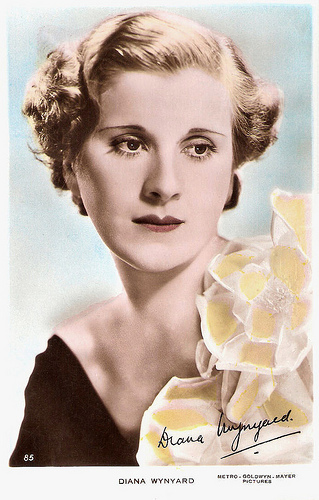
British postcard in the Art Photo series, no.85. Photo: MGM.
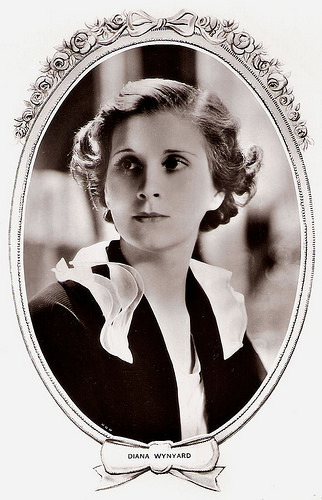
British postcard in the Cameo series, London, no. K 45. Photo: MGM.
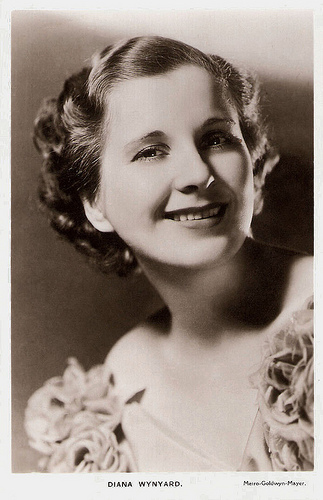
British postcard in the Film Kurier series, London, no. 63. Photo: Metro-Goldwyn-Mayer.
Star Parts
After World War II, Diana Wynyard appeared in the Oscar Wilde adaptation An Ideal Husband (Alexander Korda, 1947) as the wife in question.
Her remaining film roles were small, usually providing maternal support in roles in the 1950s such as in Tom Brown's Schooldays (Gordon Parry, 1951) and The Feminine Touch (Pat Jackson, 1956). On television she played Empress Elisabeth of Austria in Mayerling (Anatole Litvak, 1957), which starred Audrey Hepburn .
Her stage career flourished after the War, and as a Shakespearean leading lady at Stratford, in London's West End, and on tour in Australia, she had her pick of star parts. Between 1948 and 1952, she played Portia, Gertrude, Lady Macbeth, Katherine the shrew, Desdemona, Katherine of Aragon, and Hermione in The Winter's Tale.
As Beatrice to John Gielgud 's Benedick in Much Ado About Nothing, she succeeded her friend Peggy Ashcroft. Wynyard famously stumbled off the rostrum during the sleepwalking scene in Macbeth in 1948 and fell 15 feet - and continued.
Throughout the 1940s and 1950s she also had success in the works of several contemporary writers, including the British production of Tennessee Williams's Camino Real.
Her final film appearance was as the secretive mother of James Mason 's character in Island in the Sun (Robert Rossen, 1957). Her stage career continued to thrive.
In 1964, Diana Wynyard joined the National Theatre in its first year, but died from kidney ailment before the end of the season. She was only 58. Her last television performance was in the play The Man In The Panama Hat (1964). Her death occurred before the intended broadcast in May 1964 and it was eventually shown posthumously.
Diana Wynyard was married twice, first from 1943 till 1947 to Sir Carol Reed, and subsequently from 1951 on to a Hungarian physician, Tibor Csato.
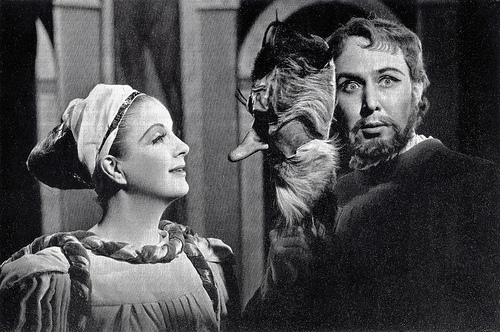
British postcard in the Shakespeare Memorial Theatre series, no. 6. Photo: Angus McBean. Diana Wynyard and Anthony Quayle as Beatrice and Benedick in Much Ado About Nothing, Stratford-upon-Avon, 1949.
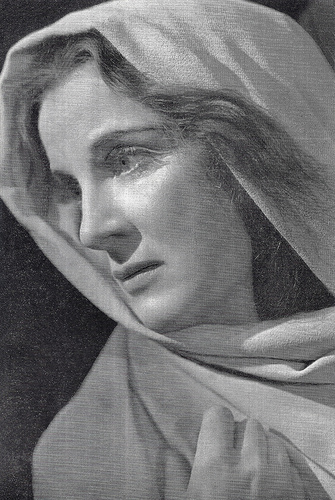
British postcard in the Shakespeare Memorial Theatre series, no. 7. Photo: Angus McBean. Diana Wynyard as Lady MacBeth, Stratford-upon-Avon, 1949.
Sources: Hal Erickson (AllMovie), British Pictures, Wikipedia, and .

British postcard by De Reszke Cigarettes, no. 3.

British postcard in the Picturegoer series, London, no. 729a. Sent by mail in 1934. Photo: MGM.

British postcard in the Picturegoer series, London, no. 906. Photo: Dorothy Wilding.
Three Barrymores
Diana Wynyard was born Dorothy Isobel Cox in London in 1906. The acting bug struck early, and by the mid-twenties she was doing walk-ons in the West End. After a spell in Liverpool rep she returned to the capital, becoming a star in Sorry You've Been Troubled.
In 1932 she appeared in New York opposite Basil Rathbone in The Devil Passes. Hollywood noticed and she appeared first as Princess Natasha in the MGM production Rasputin and the Empress (Richard Boleslawski, 1932). Wynyard managed to make an excellent impression despite the overshadowing presence of three Barrymores - John, Lionel, and Ethel - in the cast.
It was the (off screen) rape of Wynyard's character by Rasputin (Lionel Barrymore) that led an expatriate Russian princess to sue MGM, claiming that Natasha was based on the princess. This is why all subsequent American films carried the "any resemblance to any persons living or dead" disclaimer.
Fox then borrowed her for their lavish film version of Noel Coward's stage spectacle Cavalcade (Frank Lloyd, 1933). As the noble wife and mother she aged gracefully against a background of the Boer War, the sinking of the Titanic, the First World War, and the arrival of the Jazz Age. With this performance, she became the first British actress to be nominated for the Academy Award for Best Actress.
However, in an era dominated by gangster films and musicals she proved difficult to cast. Other Hollywood appearances were as John Barrymore's old flame in Reunion in Vienna (Sidney Franklin, 1933) and most notably in James Whale’s masterpiece One More River (1934) as an abused high society wife trying to wrench free of her extremely nasty husband.

British postcard in the Filmshots series by Film Weekly. Photo: Fox. Publicity still for Cavalcade (Frank Lloyd, 1933) with Diana Wynyard and Frank Lawton.

British postcard in the Filmshots series by Film Weekly. Photo: Fox. Publicity still for Cavalcade (Frank Lloyd, 1933) with Clive Brook.

French postcard, no. 34. Photo: 20th Century Fox.

British postcard, no. 91. Photo: MGM.
Tormented Heiress
After this brief and largely unsatisfactory Hollywood career, Diana Wynyard returned to Britain. Here she concentrated on theatre work, including roles as Charlotte Brontë in Clemence Dane's Wild Decembers, in Sweet Aloes, and as Gilda in the British premiere of Noel Coward's Design for Living.
She was tempted to return to the screen to play opposite Ralph Richardson in On the Night of the Fire (Brian Desmond Hurst, 1939). Then she had a great success as the frightened heroine of the first film version of Patrick Hamilton's play Gas Light (Thorold Dickinson, 1940). This is her most revived performance.
Gaslight was thought lost for years, because MGM destroyed it when they remade it with Ingrid Bergman . Fortunately, a few prints were illegally smuggled out of England and the film is still in existence. As the heiress tormented by husband Anton Walbrook Diana Wynyard is unforgettable.
Thanks to the blitz, legitimate theatre work was unpredictable so she continued to film, including roles opposite Clive Brook in Freedom Radio (Anthony Asquith, 1941), John Gielgud in The Prime Minister (Thorold Dickinson, 1941) and Michael Redgrave in Kipps (Carol Reed, 1941).
She soon married the director of Kipps, Carol Reed. With the blitz receding, she scored a bit hit on stage in Watch on the Rhine and didn't return to filming until the war (and her marriage) was over.

British postcard in the Art Photo series, no.85. Photo: MGM.

British postcard in the Cameo series, London, no. K 45. Photo: MGM.

British postcard in the Film Kurier series, London, no. 63. Photo: Metro-Goldwyn-Mayer.
Star Parts
After World War II, Diana Wynyard appeared in the Oscar Wilde adaptation An Ideal Husband (Alexander Korda, 1947) as the wife in question.
Her remaining film roles were small, usually providing maternal support in roles in the 1950s such as in Tom Brown's Schooldays (Gordon Parry, 1951) and The Feminine Touch (Pat Jackson, 1956). On television she played Empress Elisabeth of Austria in Mayerling (Anatole Litvak, 1957), which starred Audrey Hepburn .
Her stage career flourished after the War, and as a Shakespearean leading lady at Stratford, in London's West End, and on tour in Australia, she had her pick of star parts. Between 1948 and 1952, she played Portia, Gertrude, Lady Macbeth, Katherine the shrew, Desdemona, Katherine of Aragon, and Hermione in The Winter's Tale.
As Beatrice to John Gielgud 's Benedick in Much Ado About Nothing, she succeeded her friend Peggy Ashcroft. Wynyard famously stumbled off the rostrum during the sleepwalking scene in Macbeth in 1948 and fell 15 feet - and continued.
Throughout the 1940s and 1950s she also had success in the works of several contemporary writers, including the British production of Tennessee Williams's Camino Real.
Her final film appearance was as the secretive mother of James Mason 's character in Island in the Sun (Robert Rossen, 1957). Her stage career continued to thrive.
In 1964, Diana Wynyard joined the National Theatre in its first year, but died from kidney ailment before the end of the season. She was only 58. Her last television performance was in the play The Man In The Panama Hat (1964). Her death occurred before the intended broadcast in May 1964 and it was eventually shown posthumously.
Diana Wynyard was married twice, first from 1943 till 1947 to Sir Carol Reed, and subsequently from 1951 on to a Hungarian physician, Tibor Csato.

British postcard in the Shakespeare Memorial Theatre series, no. 6. Photo: Angus McBean. Diana Wynyard and Anthony Quayle as Beatrice and Benedick in Much Ado About Nothing, Stratford-upon-Avon, 1949.

British postcard in the Shakespeare Memorial Theatre series, no. 7. Photo: Angus McBean. Diana Wynyard as Lady MacBeth, Stratford-upon-Avon, 1949.
Sources: Hal Erickson (AllMovie), British Pictures, Wikipedia, and .
Published on August 07, 2017 22:00
Paul van Yperen's Blog
- Paul van Yperen's profile
- 13 followers
Paul van Yperen isn't a Goodreads Author
(yet),
but they
do have a blog,
so here are some recent posts imported from
their feed.



